Category: Delineation – Substance over Form
Delineation – determening the actual substance of deals – is the framework for analysing controlled transactions. Guidance for identifying the commercial or financial relations is provided in TPG Ch I:
- Identify the assets used and the significant risks associated with the transaction.
- Identify the contractual arrangements , including contractual assumption of risks;
- Identify the parties performing functions, using assets, and managing risks in a functional analysis.
- Confirm the consistency between contractual arrangements and the conduct of the parties, and determine whether the party assuming risks also controls risks and has financial capacity.
- Delineate the actual controlled transaction.
- Determine arm’s length prices for these transactions consistent with each party’s contributions of functions performed, assets used, and risks assumed, unless non-recognition guidance applies.
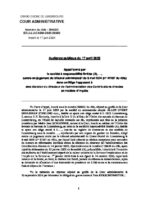
Luxembourg vs “EQ LUX”, April 2025, Administrative Court, Case No 50602C (ECLI:LU:CADM:2025:50602)
“EQ LUX” had classified its interest-free intra-group contributions as loans for tax purposes and treated a Malaysian branch with very limited substance as a permanent establishment. The tax authorities reclassified the loans as equity and denied permanent-establishment status to the branch. “EQ LUX” appealed to the Administrative Tribunal, which in May 2024 dismissed the appeal and upheld the additional-tax assessment issued by the authorities. A further appeal was lodged with the Administrative Court. Judgment The Administrative Court upheld the Tribunal’s decision and ruled in favour of the tax authorities. Applying the substance-over-form doctrine, the Court confirmed that the “loans” were, in substance, equity: they financed long-term assets, produced an excessive debt-to-equity ratio, lacked genuine repayment guarantees and, in their economic context, behaved like capital. The Court dismissed the taxpayer’s reliance on Luxembourg’s informal 85/15 leverage guideline and rejected the submitted transfer-pricing study for failing to analyse realistic alternatives. It emphasised that debt-capacity considerations belong in the initial classification exercise, not as a later adjustment. The Court also found that the Malaysian branch failed the treaty tests of having a fixed place of business, permanence and effective business activity. EQ LUX could not prove the branch’s office location, the presence of staff or any Malaysian business functions beyond a paper allocation of shares; permanent-establishment status was therefore denied. Excerpts in English “Considering that even a moderately diligent and conscientious manager, seeking to ensure the profitability of a commercial operation, would not waive the collection of interest when it has granted a loan to its subsidiary, would not advance funds while ultimately assuming all the consequences if it did not seek a certain return in the medium or long term, and would not have encouraged undercapitalisation as in the present case; that it follows that an independent creditor acting in accordance with market practice would not have granted credit to the claimant in the given situation; Considering that, in tax law, ‘hidden distribution and hidden contribution are similar transactions with the following characteristics. They involve the granting of an advantage between related parties motivated by social relations’ (Tax Studies No. 113/114/115, Guy Heintz, Income Tax on Local Authorities); Considering that it follows from the foregoing that the tax office made a correct assessment of the facts and that it was right not to recognise the existence of a permanent establishment in Malaysia, while reclassifying the alleged debt instruments as hidden contributions; ” “In view of the above, the appellant’s argument concerning the existence of a fixed place of business in the form of a branch in Malaysia must be rejected and the court’s assessment on this point must be upheld. Consequently, this second part of the appeal is unfounded and the judgment under appeal must be upheld in this respect. Since the Court has just held, like the first judges, that the Direct Taxation Authority validly reclassified the disputed loans on the basis of the principle of economic assessment and validly found that there was no alleged branch and, therefore, no permanent establishment of the appellant in Malaysia, the question of whether there was an abuse of rights is no longer relevant. The tax treatment criticised by the appellant is already justified by these conclusions, since, in the absence of a permanent establishment in Malaysia, Luxembourg retains the right to tax the appellant’s income and net assets and it is not possible for the appellant to have transferred its shareholdings to a non-existent branch. In other words, since the appellant has failed to meet the burden of proof incumbent upon it to demonstrate the facts on which it relies in order to obtain tax treatment different from that adopted by the Direct Taxation Administration, it is not necessary to consider the issue of abuse of rights in order to justify the tax treatment criticised.” Click here for English translation Click here for other translation
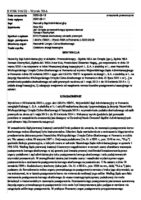
Poland vs “Fertilizer TM S.A.”, March 2025, Supreme Administrative Court, Case No II FSK 916/22
A Polish fertilizer manufacturer, “Fertilizer TM S.A.”, had transferred legal ownership of its trademarks to its subsidiary “B” and then paid substantial royalties for the use of the same trademarks. The tax authority considered B’s role to be merely “administrative” and recharacterised the licence agreement as a contract for trademark management services. On this basis, the tax deductions taken by “Fertilizer TM S.A.” were significantly reduced and an assessment of the resulting additional taxable income was issued. On appeal, the assessment was upheld by the Court of First Instance and the case was then brought before the Regional Administrative Court. In April 2022 the Regional Administrative Court concluded that, under the provisions of the Income Tax Act in force during the period under review (2013-2014), the tax authority could not lawfully disregard a valid licence agreement or replace it with another type of service agreement. Article 11 of the CIT Act, in its previous version, allowed the authorities to estimate income only if they could prove that the prices set between related entities deviated from arm’s length standards. However, it did not allow the authorities to reclassify legal transactions; such a power was introduced in 2019. The Court stressed that, if the ownership of the trademarks was effectively transferred to B and “Fertilizer TM S.A.” then needed a valid licence to continue using them, the central question was whether the licence fees themselves reflected market conditions. The Court held that, in order to assess whether the amount of the licence fee was at arm’s length, the authorities had to apply recognised transfer pricing methods – comparable uncontrolled price, cost-plus or resale price – and only if these methods could not be used should they resort to transactional profit methods. By relying on the 2017 OECD Guidelines (which significantly changed aspects of transfer pricing analysis and included concepts that had not been translated into Polish at the time of the transaction), the authorities improperly applied principles that were not legally binding in 2013-2014. The court ordered the tax authority to reconsider the matter and correctly assess “Fertilizer S.A”‘s income and allowable licensing costs by valuing the royalty payments under the appropriate transfer pricing methods, rather than rejecting them on the grounds that B was merely a “manager” of the trademarks. An appeal was then filed with the Supreme Administrative Court. Judgment The Supreme Administrative Court upheld the decision of the Regional Administrative Court. Click here for English Translation Click here for other translation
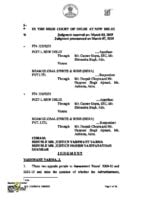
India vs Beam Global Spirits & Wine (India) Pvt.Ltd., March 2025, High Court of Delhi, ITA 155/2022
The core issue was whether Beam Global Spirits & Wine’s Advertisement, Marketing, and Promotion expenses for brand promotion constituted an “international transaction” under Section 92B of the Income Tax Act, thereby warranting a transfer pricing adjustment. The tax authorities had applied the Bright Line Test to determine that the AMP expenditure was excessive compared to comparable companies, inferring from this a presumed international transaction with the foreign associated enterprise and making an arm’s length price adjustment. On appeal, the Income Tax Appealante Tribunal overturned the tax authorities adjustment, holding that the existence of an international transaction must be established by tangible evidence—such as an agreement or arrangement—and not by inference from advertisement, marketing, and promotion spending alone. An appeal was then filed by the tax authorities with the High Court. Judgment The High Court dismissed the appeals and upheld the ITAT’s view, reiterating principles from previous rulings, especially Maruti Suzuki and Sony Ericsson. The Court emphasized that: A transfer pricing analysis under Chapter X of the Act can only be initiated if there is a demonstrable international transaction. The mere use of a foreign brand or incurrence of high advertisement, marketing, and promotion expenses does not, by itself, imply a transaction exists. The Bright Line Test is not a valid legal tool for inferring the existence of an international transaction or for computing arm’s length pricing. The retrospective clarification to Section 92B (via the 2012 Explanation) does not override the need for proving an actual agreement, understanding, or concerted action between associated enterprises. There is no statutory machinery in the Indian transfer pricing regime to permit quantitative adjustments based solely on advertisement, marketing, and promotion expenditure. Accordingly, the Court found no basis for the tax authorities benchmarking and transfer pricing adjustment in the absence of a proven international transaction, and dismissed the Revenue’s appeals. Click here for other translation
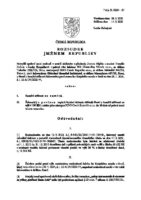
Czech Republic vs RR Donnelley Czech s.r.o., February 2025, Supreme Administrative Court, Case 7 Afs 31/2024 – 27
The assessment centered on whether RR Donnelley’s pricing with a related party reflected arm’s length terms under Section 23(7) of the Czech Income Tax Act. In particular, the tax authorities claimed that RR Donnelley was essentially lending funds to a related party by purchasing materials (disk drives, HDDs) on the latter’s behalf. They argued that this was a virtually risk-free transaction akin to a deposit of funds, so they chose the USD LIBOR rate as a reference for what an arm’s length return would look like. RR Donnelley appealed, and the Regional Court agreed in part that the transaction might have been low-risk. However, it ruled that the tax authorities had not thoroughly or transparently established a proper arm’s length price, nor had they shown why no comparable transactions could be found. Simply relying on the USD LIBOR rate did not suffice, since that rate applies to short-term interbank lending—an entirely different context from internal inventory purchases by non-banking companies. According to the Regional Court, this lack of a reasoned analysis made the tax authorities’ decision unreviewable, and so the decision was annulled and sent back for further proceedings. An appeal was then filed by the tax authorities with the Supreme Administrative Court. Judgment The Supreme Administrative Court agreed with the Regional Court. Although Czech law allows tax authorities to use various methods to approximate an arm’s length price in related-party transactions, it also requires that the chosen approach be adequately explained and grounded in economically comparable data. The Court found that the tax authorities had failed to document why the USD LIBOR rate should govern a transaction between a manufacturer and its affiliate, or why comparable arm’s length data could not be located. Because the tax authority’s rationale for its chosen reference price was conclusory and unsupported, the Supreme Administrative Court dismissed the appeal and maintained the Regional Court’s annulment of the assessment. Click here for English Translation Click here for other translation
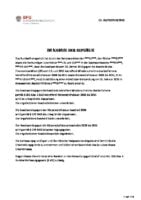
Austria vs “Health & Beauty AG”, February 2025, Bundesfinanzgericht, Case No GZ RV/7100946/2016
“Health & Beauty AG” acted as a holding company within a larger international group. It had acquired 51% of the shares in I-GmbH in 2003 and the remaining 49% in 2009 from two Irish investment companies. The acquisition of the remaining shares was financed by a €12.4 million loan from A-BV at an interest rate of 7.855%. The loan was repaid early in 2013-2014 and interest expenses were claimed for the years 2009 to 2011. It had also deducted interest expences related to financing of subsidiaries in Spain and Italy. The tax authorities disallowed the deduction of these interest payments and an appeal was lodged, which ended up at the Austrian Federal Finance Court. Decision The court found that the loan agreement regarding the Acquisition of I-Gmbh was properly documented and at arm’s length and therefore the interest was deductible. It also concluded that “Health & Beauty AG” was the beneficial owner of the shares in I-GmbH, as it bore the risks and had the powers typical of an owner. Coordination with the group’s central departments did not negate its ownership status, nor did internal financial control or the fact that the purchase price was paid by another group company. The court rejected the tax authority’s claim that the structure was abusive because no tax benefits were realised from the transactions in question. Regarding interest expenses connected to group-financed grants to subsidiaries in Italy and Spain, the Court found that a large portion of the intra-group loans effectively was hidden equity contributions, thus disallowing the corresponding interest costs. The court also considered a dispute over the valuation of liabilities for unredeemed vouchers older than three years. It ruled that such liabilities should not be fully recognised at face value due to the extremely low probability of redemption, resulting in an upward adjustment of taxable income for 2011. Click here for English translation Click here for other translation
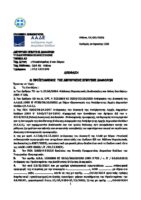
Greece vs “Dairy Distributor S.A.”, February 2025, Administrative Tribunal, Case No 330/2025
“Dairy Distributor S.A.” produces a variety of dairy products and sells to consumers in the Greek market products produced in its own factory or by other Group companies. For the rights to use the trademarks and know-how for its production and sales activities, “Dairy Distributor S.A.” had entered into a trademark licence agreement and a know-how licence agreement with a related party in the Netherlands and until 2017 paid a royalty for the use of trademarks of 2% on net sales and a royalty for the use of know-how of 2% on net sales of locally produced products. In 2018, “Dairy Distributor S.A.” was changed from a limited risk distributor to a full risk distributor and was now also required to pay royalties for know-how on net sales of products that it did not produce itself. Following an audit for FY2018 – FY2022, the tax authorities disallowed deductions for these additional royalty payments, concluding that these did not comply with the arm’s length principle or qualify as payments for genuine know-how rights. The authorities also disallowed the deductions for these payments as intra-group services, as they found no evidence that these services conferred a distinct, additional benefit to the local entity – particularly as it already possessed the expertise needed to sell the products. “Dairy Distributor S.A.” appealed to the Directorate of Dispute Settlement. Decision The Directorate rejected the appeal and confirmed the tax assessment issued by the tax authorities. Click here for English translation Click here for other translation
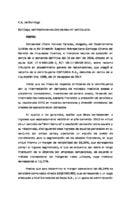
Chile vs CAPITARIA S.A., October 2024, Court of Appeal, Case N° Rol: 191-2024
Capitaria S.A.’s main lines of business are financial services. The case concerned a dispute over transfer pricing calculations made by Capitaria S.A. in relation to a joint venture agreement with a related foreign company, KT Financial Group BVI. Capitaria had segmented its financial statements to separate income derived from various business lines, including currency derivatives brokerage and advisory services, and had reported an operating margin of 69.24% for the joint venture activity in its 2014 tax return. The tax authorities contested the segmentation methodology, arguing that the line items for costs and expenses were not clearly attributable to the joint venture and that accepting Capitaria S.A.’s approach could pave the way for erosion of the tax base. An appeal was filed by Capitaria S.A. with the District Court, which upheld it’s claim after evaluating the transfer pricing study and the supporting documentary evidence. The court found that the segmented results sufficiently demonstrated the profitability margin from the joint venture contract and that there was an adequate basis to treat the relevant revenues, costs, and expenses as distinct from other business lines. An appeal was then filed by the tax authorities with the Court of Appeal. Judgment The Court of Appeal dismissed the appeal and confirmed the ruling of the court of first instance, noting that the lower court had properly weighed the evidence under rules of sound criticism. There was no error in the judge’s reasoning, which rested on the thorough examination of the taxpayer’s transfer pricing study and the plausibility of the allocated costs and revenues. As a result, the annulment of the tax authorities’ assessment was maintained, confirming the legitimacy of the taxpayer’s reported margin for the 2014 tax year. Excerpt in English “Secondly: As stated in the case file, in the 2014 tax year, the claimant reported in DJ No. 1907 that during that period it carried out a transaction with the related company KT Financial Group BVI, domiciled in the British Virgin Islands, reporting a return of 69.24%. Likewise, it can be seen that it is an undisputed fact that on 30 December 2009, the taxpayer signed a joint venture contract with the foreign company KT Financial Group BVI and that it presented a transfer pricing study which indicates that for the calculation of the profitability margin of 69.24%, when applying the valuation method it proposes, segmented its results, as demonstrated by the profuse documentary evidence provided as part of the evidence. Third: That, from the analysis of the appealed ruling, it can be seen that the trial judge reached his verdict after scrutinising the evidence presented at trial in accordance with the rules of sound criticism, based on the multiplicity, gravity and precision of the evidence and in accordance with the legal, logical and technical reasons developed in the thirteenth ground, which certainly support and give reasonableness to the decision adopted, validating the profitability declared by the taxpayer in the 2014 tax year. logical and technical reasons that he develops in the thirteenth reason, which certainly give support and reasonableness to the decision adopted, validating the returns declared by the taxpayer in the 2014 tax year and the calculation methodology applied based on the transfer pricing study she provided. Fourth: That, for the reasons noted, this Court shares the decision of the judge of first instance and finds that the judge weighed and assessed the evidence presented on its merits, as can be seen from the twelfth ground of the judgment under review, the appeal cannot be upheld, since, in the opinion of this court, the flaws and errors denounced by the appellant in the appeal she is attempting are not observed.”. Click here for English translation Click here for other translation
Italy vs Costa Crociere SpA, July 2024, Supreme Court, Case No 20228/2024
One of the issues in this case was the arm’s length nature of an agency agreement between Costa Crociere and its Brazilian subsidiary, Costa Cruzeiros Agencia Maritima e Turismo Ltda. The tax authorities had reclassified the said agency agreement between Costa Crociere and its Brazilian subsidiary as a loan. According to the tax authorities, the funds transferred under this agreement, amounting to approximately €40 million, were in fact a long-term loan and, on this basis, interest income was added to Costa Crociere’s taxable income on the basis of transfer pricing adjustments using a LIBOR interest rate adjusted for country risk. In the appeal to the Supreme Court, Costa Crociere argued that the tax authority had no right to recharacterise the transaction as a loan and, if permissible, had incorrectly calculated the interest due. Judgment The Supreme Court disagreed that the tax authorities were bound by the agreement between Costa Crociere and its Brazilian subsidiary. However, the Court agreed with Costa Crociere that the lower courts had not adequately analyzed the economic substance of the transaction, the actual risks borne by both parties, or the parent company’s own financial records. As a result, the case was sent back to the Liguria Regional Tax Commission for further review, with instructions to conduct a detailed analysis based on these legal principles. Excerpts in English “7.5. The case law of the Court, on the subject of transfer pricing, relating to non-interest-bearing financing (most recently Supreme Court of Cassation 20/05/2021, no. 13850; Supreme Court of Cassation 15/11/2017, no. 27018), holds that ‘the assessment “based on the normal value” is irrespective of the original capacity of the transaction to produce income and, therefore, of any negotiating obligation of the parties relating to the payment of the consideration (see OECD Transfer Pricing Guidelines for Multinational Enterprises and Tax Administrations, paragraph 1.2). It is, in fact, a matter of examining the economic substance of the transaction that has taken place and comparing it with similar transactions carried out, in comparable circumstances, in free market conditions between independent parties and assessing its conformity with these>>. Paragraphs 1.121 et seq. of the OECD Guidelines (in the 2017 version) envisage the possibility of disallowing or substituting the transaction between the parties, but under very strict conditions and, above all, after all the necessary steps have been taken to accurately delineate the actual transaction between the parties, which is a preliminary operation in any transfer pricing analysis; to this end, it is necessary to start from the content of the contract, examine the actual economic substance of the transaction, its commercial rationality and always with reference to the need to compare it with similar transactions between independent enterprises. Para. 1.122 provides that <>; while para. 1.123 provides that <>. 7.6. In light of these considerations, it must therefore be held, firstly, that the CTR did not make any assertion in breach of the principle of allocation of evidentiary burdens but examined the merits of the respective deductions; secondly, it must be noted that the decision of the case did not exclusively pose a problem of interpretation of the contract (as the Attorney General’s Office held, in order to support the inadmissibility of the plea); thirdly, it should be noted that the office, and therefore the CTR, was not precluded in the abstract from re-qualifying the contract (thus proving unfounded the first complaint of the first plea, which highlighted the absolute inadmissibility of a re-qualification); However, it must be held that the appeal judges erred, in disallowing and replacing the transaction between the parties, in giving relevance solely to the accounting data of the subsidiary, which had included those items in medium- and long-term debts, without actually examining in the least the content of the contract, its economic substance, the risks contractually assumed and the accounting carried out by the parent company (which carried out a careful analysis and explanation of its own accounting) and, above all, in making a comparison with similar situations. The plea should therefore be upheld in the terms set out above, and the judgment should be set aside on this point, with a reference back to the Court of Tax Appeals at second instance for it to carry out a new examination in the light of the aforementioned principles. 9. In conclusion, the third plea in the main appeal must be upheld, the first plea absorbed and the others dismissed; the first plea in the cross-appeal must also be upheld, the second dismissed and the third dismissed. The judgment should be set aside in relation to the grounds upheld, with reference back to the Court of Second Instance of Liguria, in a different composition, which will have to rule on the basis of the aforementioned principles of law, and to which the task of ruling on the costs of the proceedings of legitimacy is assigned.” Click here for English translation Click here for other translation
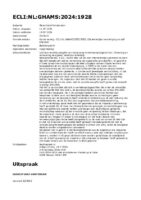
Netherlands vs “Agri B.V.”, July 2024, Court of Appeal, Case No 22/2419 (ECLI:NL:GHAMS:2024:1928)
“Agri B.V.” is a Dutch subsidiary of an international group active in the processing of agricultural products. Following a restructuring in 2009, Agri B.V. had declared taxable profits of €35 million, including €2 million in exit profits. This amount was adjusted to more than €350 million. According to the tax authority an ongoing business had effectively been transfered to a Swiss affiliated company as a result of the restructuring of the group, and profits from the transfer had not been declared by “Agri B.V.” for tax purposes. “Agri B.V.” then filed an appeal and in 2022, the District Court ruled largely in favour of the tax authorities. But the Court significantly reduced the value on the basis of an expert valuation report. An appeal was then filed with the Court of Appeal. Judgment The Court of Appeal largely upheld the judgment of the District Court. The Court ruled that the tax authority had made it plausible that something of additional value had been transferred to the Swiss affiliated company for which they had wrongly not stipulated any remuneration that the inspector (also in view of the minimum value calculated by an expert of what was transferred in total) was right for that reason to make a transfer price adjustment, and that he had also made it plausible that the interested party had not filed the required return as referred to in Section 27e AWR, so that the burden of proof should be reversed and increased. Click here for English translation Click here for other translation
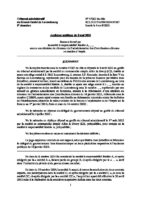
Luxembourg vs “EQ LUX”, May 2024, Administrative Tribunal, Case No 47267 (ECLI:LU:TADM:2024:47267)
“EQ LUX” had classified its interest-free intra-group contributions as loans for tax purposes and treated a Malaysian branch with very limited substance as a permanent establishment. The tax authorities reclassified the loans as equity and denied permanent-establishment status to the branch. “EQ LUX” appealed to the Administrative Tribunal. Dicision of the Tribunal The Administrative Tribunal dismissed the appeal of “EQ LUX” and ruled in favour of the tax authorities. Click here for English translation Click here for other translation
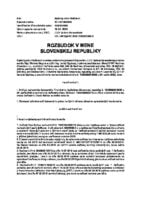
Slovakia vs Marelli PWT Kechnec Slovakia s.r.o., April 2024, Administrative Court, Case No. KE-7S/148/2020
Marelli Slovakia’s main business is the manufacture of automotive engine and transmission components and that its main products are throttle bodies, throttle position sensors and high-pressure fuel pumps. The parent company is Magneti Marelli S.p.A., Italy, which owns 100 % of the shares of the company, and the parent company of the entire group is Fiat S.p.A. In an audit of corporate income taxes for FY 2012 the tax authorities compared the resale price method, the cost plus method and the net margin method, and stated the reasons why it had chosen the net margin method as the most appropriate method for assessing the arm’s length pricing of the controlled transactions relating to the intra-group sale of Marelli Slovakia’s products. In comparing the terms and conditions agreed in the commercial relationships, it took into account the activities carried out by Marelli Slovakia in production, purchasing and sales, as well as the extent of the business risks, the contractual terms and conditions agreed, etc. The tax authorities carried out a functional and risk analysis, evaluated the functions performed by Marelli Slovakia and those performed by the parent company or other companies of the Magneti Marelli group and found that Marelli Slovakia bore risks over which it had no control or decision-making power, the control and decision-making in significant activities being largely the responsibility of the parent company, Magneti Marelli S.p.A. According to the tax authorities Marelli Slovakia performed the functions and activities of a production plant and had the profile of a contract manufacturer, or a manufacturer with limited functions and risks, which generally produces on demand and is supposed to have all costs paid and, since it does not bear high risks, has only a small profit. According to the tax authorities, assessing the various individual transactions separately would not provide a comprehensive view of Marelli Slovakia’s activities and their interrelationship with the main manufacturing activity. The tax authority used the Amadeus database to search for independent comparable companies and carried out a quantitative and qualitative analysis, finding that Marelli Slovakia had achieved a profit margin of -6,01 % for the tax year under review, which was not within the established range of independent comparable profit margins of 3,62 % to 7,49 % (median 5,85 %). For that reason, the tax authorities adjusted Marelli Slovakia’s profit margin to the median value, i.e. 5,85 %, thereby increasing the tax base by EUR 2 458 414,42. Judgment of the Administrative Court The administrative court annulled the assessment made by the tax authorities. The case was sent back to the tax authorities for further proceedings, with instructions to correct the procedural and substantive legal issues identified by the court. Click here for English translation Click here for translation
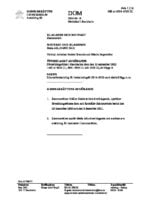
Sweden vs Meda AB, April 2024, Administrative Court of Appeal, Case No 6754-6759-22
Meda AB, the parent company of a Swedish pharmaceutical group, had established a subsidiary in Luxembourg. The subsidiary was the contractual owner of intangible assets that was acquired from external parties following its establishment. Licensing and distribution agreements had then been entered into, according to which the subsidiary would receive the residual profit from the ownership of the intangible assets, while Meda AB and other group companies would only receive routine compensation for services rendered in connection with the intangible assets. The tax authorities found that the contractual terms of the agreements did not reflect the actual transactions. According to the tax authorities, Meda AB had been the actual decision maker and had controlled the significant risk related to the intangible assets. On this basis, it was concluded that the subsidiary in Luxembourg should only be compensated on a cost-plus basis for providing administrative services, while the remaining profits should be allocated 60% to Meda AB and 40% to other group companies. Meda AB appealed to the Administrative Court, arguing that an arm’s length assessment could only be based on the contractual terms and that the consideration of risk control and the delineation of actual transaction was contrary to the Swedish arm’s length provisions and the version of the OECD Transfer Pricing Guidelines in force for the tax years in question. The Administrative Court agreed with Meda AB and annulled the assessment. The tax authorities then appealed to the Court of Appeal. Judgment The Court of Appeal overturned the decision of the Administrative Court and upheld the assessment of the tax authorities. The Court found that the agreed terms between the related parties had not been at arm’s length. Therefore, there was a basis for adjusting Meda AB’s results under the Swedish arm’s length provisions. On the issue of the OECD transfer pricing guidelines, the Court clarified that later versions of the guidelines could be applied. The Court also stressed the importance of taking into account all relevant circumstances when examining transactions between related parties. The Court found that the Luxembourg subsidiary had only been the formal owner of the intangible assets, while Meda AB and other group companies had performed all the valuable functions and controlled the main risk related to the intangibles. Meda AB subsequently applied to the Supreme Administrative Court for permission to appeal, which was denied. Excerpts in English “The Supreme Administrative Court has stated that the OECD’s Transfer Pricing Guidelines for Multinational Enterprises and Tax Administrations provide a good and well-balanced explanation of the problems surrounding transfer pricing issues and that the guidelines can serve as a guide in the application of the correction rule, even if they are not binding (RÅ 1991 ref. 107 and HFD 2016 ref. 45). In the opinion of the Administrative Court of Appeal, the guidelines can also be used as guidance for tax years before they were issued, provided that they do not change what applied according to previous versions and do not conflict with the Swedish correction rule. The Administrative Court of Appeal notes that there are differences between the 2017 version and previous versions. However, using the 2017 version in a case such as the present one does not mean that what is to be assessed is changed or expanded in relation to what would have applied if guidance had instead been taken from the previous guidelines. There is therefore no obstacle to using the 2017 Guidelines as guidance in the Court of Appeal’s assessment.” “The Administrative Court of Appeal notes that a review under the correction rule is about assessing what independent parties would have agreed if they were in a similar situation. It is thus a matter of assessing how independent parties would have acted if they had had the same contractual relationship as the related parties have. In order to identify what constitutes an equivalent situation, i.e. a comparable transaction under comparable circumstances, it is necessary, in the Court of Appeal’s opinion, to take into account all the related parties’ dealings and actual behaviour, as well as other economically relevant circumstances associated with their contractual relationship. This means that circumstances other than the actual contractual terms also need to be taken into account in the assessment under the correction rule (HFD 2016 ref. 45 and OECD Guidelines, paragraphs 1.33, 1.36, 1.43 and 1.45). In transactions between independent parties, compensation is normally paid that reflects the functions performed by each party, the assets used and the risks borne (OECD Guidelines, paragraph 1.51). The Swedish Tax Agency argues that it is the allocation of the functions and risks in the acquisition of the product rights that must be analysed in order to identify and map the transactions actually undertaken between the company and the subsidiary. It is therefore these questions that the Administrative Court of Appeal will examine in the following. According to the Court of Appeal, this examination is not about the actual meaning of the legal acts.” “According to the OECD guidelines, the right of return belongs to the party that performs or controls the more important functions and risks associated with intangible assets. Mere legal ownership does not give the right to compensation (cf. paragraphs 6.42, 6.47-6.49 and 6.54). The Administrative Court of Appeal is of the opinion that the Swedish Tax Agency’s investigation shows that the most value-creating and risky function of the product rights has been the acquisitions themselves. Since the purchases have amounted to very large amounts, the acquisition risks have been significant. The return for having controlled these risks should therefore, in the Court of Appeal’s opinion, have accrued to the company, which has not been reflected in the terms of the agreement between the company and the subsidiary.” “The Administrative Court of Appeal then makes the following assessment regarding the compensation that, according to the Tax Agency’s decision, is to accrue to the subsidiary. As regards the risk-free return on the subsidiary’s investments, the Administrative Court of Appeal makes no other assessment than that the investment is risk-free
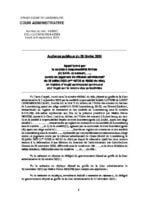
Luxembourg vs “Lux Leasing”, February 2024, Administrative Court, Case No 49388C (ECLI:LU:CADM:2024:49388)
For tax purposes, “Lux Leasing” considered itself the owner of certain intangible assets (trademarks) that it had licensed from a related party in the US under a 25-year renewable agreement and applied the IP exemption regime in Luxembourg. The tax authorities disagreed that “Lux Leasing” was the legal owner of the intangibles and therefore disagreed that the conditions for the application of the IP exemption regime were met. “Lux Leasing” appealed to the Administrative Tribunal, which dismissed the appeal and ruled in favour of the tax authorities. An appeal was then lodged with the Administrative Court. Judgment The Administrative Court upheld the decision of the Administrative Tribunal and ruled in favour of the tax authorities. The court held that “Lux Leasing” had not provided sufficient evidence to prove that economic ownership of the intangibles was transferred under the disputed licence agreement. The court pointed out that the disputed licence agreement clearly stated that the US licensor was the sole owner of the rights to the trademarks. The court considered that the related parties’ intention was clear and unequivocal from the terms of the agreement and that there was no reason to believe that the economic reality should differ from the legal form chosen. Excerpt in English “Consequently, the alleged transfer of economic ownership of the intellectual property rights at issue had not been sufficiently established, so that the Director rightly upheld the tax office’s finding that the conditions for the application of Article 50bis LIR had not been met on the grounds that company (A) was not to be considered the legal or economic owner of the intellectual property rights at issue, with the resulting consequences for the taxation of the assets of company (A) pursuant to paragraph 60bis BewG and for the taxation of the income earned by company (A) as a result of the sub-licence agreements and as a result of the assignment of its rights under the licence agreement, There is no need to consider the appellants’ alternative argument that the Court should find that economic ownership of the Trademarks had been transferred to the beneficiaries of the sub-licence agreements, as this analysis is superfluous. Contrary to what is argued by the appellants in the alternative, the finding that company (A) is not the owner of the economic property in the Trademarks does not imply that Luxembourg loses its right to tax the income declared by it, but only has the consequence that such income does not qualify for the exemption provided for by Article 50bis LIR, the appellants’ related argument being based on the erroneous premise that only the owner of the Trademarks could generate taxable income. For the rest, the Court agrees with the reasoning of the first judges in relation to this plea, which it accepts in its entirety. The related plea must therefore be rejected, in the absence of any further details provided by the appellants. It follows from all of the foregoing that the appeal must be dismissed and the judgment a quo confirmed.” Click here for English translation Click here for other translation
Portugal vs A S.A., November 2023, Supreme Administrative Court , Case 0134/10.3BEPRT
A S.A. had transferred a dividend receivable to an indirect shareholder for the purpose of acquiring other companies. The tax authorities considered the transfer to be a loan, for which A S.A should have received arm’s length interest and issued an assessment on that basis. A complaint was filed by A S.A. with the tax Court, which ruled in favour of A S.A. and dismissed the assessmemt in 2021 An appeal was then filed by the tax authorities with the Supreme Administrative Court. Judgment of the Court The Supreme Administrative Court upheld the decission of the tax court and dismissed the appeal of the tax authorities. According to the Court the local transfer pricing in article 58 of the CIRC, in the wording in force at the time of the facts did not allow for a recharacterization of a transaction, only for a re-quantification. A recharacterization of the transaction would at the time of the facts only be possible under the Portuguese general anti-abuse clause, which required the tax authorities to prove that the arrangement had been put in place for securing a tax advantage. Such evidence had not been presented. Excerpt “In other words, the fact that the transfer of credits arising from ancillary benefits to non-shareholders is not common is not enough to destroy the characteristics of the ancillary obligation set out in the articles of association, which, as is well known, can be transferred – see art. Furthermore, the Tax Authority’s reasoning reveals a total disregard for the rest of the applicable legal regime, namely the restitution regime provided for in Article 213 of the CSC, which gives them the unquestionable character of quasi-equity benefits. In fact, since the admissibility of supplementary capital contributions in public limited companies has been debated for a long time, but with the majority of legal scholars being in favor of such contributions, the enshrinement in the articles of association of the figure of accessory obligations following the supplementary contributions regime appeared as a solution to the possibility of internal financing of the public limited company, (See, for example, Paulo Olavo Cunha in Direito das Sociedades Comerciais, 3rd edition, Almedina, 2007, pages 441 and 442 (in a contemporary annotation with the legal framework in force at the time). ) . Furthermore, as pointed out by the Deputy Attorney General, whose reasoning, due to its assertiveness, we do not hesitate to refer to again, “This situation is not unrelated to the fact that, in the corporate structure in question, the company “D… ” has a majority stake in the company “A…”, and there is even doctrine that defends “the possibility of transferring the credits resulting from the supplementary installments autonomously from the status of partner” – in an explicit allusion to the view taken by Rui Pinto Duarte (Author cited, “Escritos sobre Direito das Sociedades”, Coimbra Editora, 2008). In conclusion: if the Tax Administration believed that the evidence it had found, to which we have already referred, strongly indicated that the transaction in question was really about the parties providing financing to the company “D…, S.A. “, it was imperative that it had made use of the anti-abuse clause (although there are legal scholars who also include article 58 of the CIRC in the special anti-abuse rules – see Rui Duarte Morais, “Sobre a Notção de “cláusulas antiabusos”, Direito Fiscal, Estudos Jurídicos e Económicos em Homenagem ao Prof. Dr. António Sousa Franco III 2006, p.879 /894) and use the procedure laid down in Article 63 of the CPPT, as the Appellant claims. What is not legitimate, however, in these circumstances, “in view of the letter of the law and the teleology of the transfer pricing system as enshrined in the IRC Code and developed in Ministerial Order 1446-C/2001, is to use this system to carry out a sort of half-correction and, in the other half, i.e., For cases of this nature, there is a specific legal instrument in the legal system – the CGAA – specially designed and aimed at combating this type of practice (Bruno Santiago & António Queiroz Martins, “Os preços de transferência na compra e venda de participações sociais entre entidades relacionadas”, Cadernos Preços de Transferência, Almedina, 2013, Coordenação João Taborda Gama). …” Click here for English translation. Click here for other translation
US vs GSS HOLDINGS (LIBERTY) INC., September 2023, U.S. Court of Appeals, Case No. 21-2353
GSS Holdings had claimed a loss of USD 22.54 million which the IRS disallowed. In disallowing the loss, the IRS claimed that the loss was not an ordinary business loss, but was incurred as part of a series of transactions that resulted in the sale of capital assets between related parties. The trial court upheld the IRS’s adjustment and GSS Holdings appealed to the Court of Federal Claims. The Court of Federal Claims applied a combination of substance over form and step transaction doctrines to combine two transactions and dismissed GSS Holdings’ claims on that basis. GSS Holdings then appealed to the US Court of Appeals. Opinion of the Court The Court of Appeals found that the Federal Claims Court had misapplied the step transaction doctrine and remanded the case for reconsideration under the correct legal standard. Excerpt “As part of this examination, the Claims Court must determine the outset of the series of transactions, keeping in mind that the series of transactions should be considered as a whole. Comm’r v. Clark, 489 U.S. 726, 738 (1989); see also True, 190 F.3d at 1177; Brown v. United States, 868 F.2d 859, 862 (6th Cir. 1989). The parties dispute the timeframe for the outset, with GSS advocating for the 2006 and 2007 timeframe when the Aaardvark LAPA and First Loss Note agreement were negotiated and entered, and the government advocating for the 2011 timeframe when the Aaardvark LAPA was renewed6 and exercised and when the First Loss Note Account payment was made to BNS. See Appellant’s Br. 33, 44–45; Appellee’s Br. 30–31. Once the outset’s timeframe has been assessed, the Claims Court must determine the intent from the outset, which is an- other disputed issue between the parties. See Falconwood, 422 F.3d at 1349; Appellant’s Br. 46–48; Appellee’s Br. 30–37. If the Claims Court does conclude that the separate transactions were “really component parts of a single transaction intended from the outset to be taken for the purpose of reaching the ultimate result,” then the step transaction doctrine applies. See Falconwood, 422 F.3d at 1349 (citation omitted). The Claims Court should conduct this analysis on remand. We are not suggesting any particular outcome; we are simply instructing the Claims Court to apply the correct legal standard. Even if the Claims Court applied an erroneous legal standard, the government contends that the intent was the same regardless of the timeframe, and that the Claims Court agreed. See Appellee’s Br. 37 (first citing Decision at 489 (“A payment from the First Loss Note [A]ccount was always anticipated to be at least a partial offset of losses resulting from the sale of a distressed asset.”); and then citing Decision at 489 n.22 (“The First Loss Note was always intended to absorb the first loss stemming out of a decline in Liberty[] [Street]’s investments.”)); see also Appellee’s Br. 30–34. In other words, the government con- tends that the same outcome would be reached under the correct legal standard. GSS disagrees, contending that the intent differed at various timeframes. See Appellant’s Br. 46–48; Appellant’s Reply Br. 11–15. Since the Claims Court applied an incorrect legal standard, the Claims Court “should make a new determination under the correct standard in the first instance.” Walther, 485 F.3d at 1152 (declining to reach the merits of a similar argument). To the extent any finding of the Claims Court “is derived from the application of an improper legal standard to the facts, it cannot be allowed to stand.” Id. (citations omitted). “In such a circumstance, this court must remand for new factual findings in light of the correct legal standard.” Id. GSS contends that under the correct legal standard, the step transaction doctrine would not operate to collapse the individual steps into a single integrated transaction for tax purposes. See Appellant’s Br. 44–52. In other words, GSS urges this court to reach a determination under the correct legal standard in the first instance. But just as we will not do so at the government’s request, we will not do so at GSS’s request.” Click here for translation
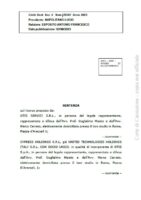
Italy vs Otis Servizi s.r.l., August 2023, Supreme Court, Sez. 5 Num. 23587 Anno 2023
Following an audit of Otis Servizi s.r.l. for FY 2007, 2008 and 2009 an assessment of additional taxable income was issued by the Italian tax authorities. The first part of the assessment related to interest received by OTIS in relation to the contract called “Cash management service for Group Treasury” (hereinafter “Cash Pooling Contract”) signed on 20 March 2001 between OTIS and the company United Technologies Intercompany Lending Ireland Limited (hereinafter “UTILI”) based in Ireland (hereinafter “Cash Pooling Relief”). In particular, the tax authorities reclassified the Cash Pooling Agreement as a financing contract and recalculated the rate of the interest income received by OTIS to be between 5.1 and 6.5 per cent (instead of the rate applied by the Company, which ranged between 3.5 and 4.8 per cent); The second part of the assessment related to of the royalty paid by OTIS to the American company Otis Elevator Company in relation to the “Licence Agreement relating to trademarks and company names” and the “Agreement for technical assistance and licence to use technical data, know-how and patents” signed on 1 January 2004 (hereinafter referred to as the “Royalty Relief”). In particular, the tax authorities had deemed the royalty agreed upon in the aforesaid contracts equal to 3.5% of the turnover as not congruous, recalculating it at 2% and disallowing its deductibility to the extent of the difference between the aforesaid rates. Not satisfied with the assessment an appeal was filed by OTIS. The Regional Tax Commission upheld the assessments and an appeal was then filed with the Supreme Court. Judgment of the Supreme Court The Court decided in favour of OTIS, set aside the assessment and refered the case back to the Regional Tax Commission in a different composition. Excerpt related to interest received by OTIS under the cash pooling contract “In the present case, the Agenzia delle Entrate redetermined the rate of the interest income received by the OTIS in relation to the contract between the same and UTILI (cash pooling contract) concerning the establishment of a current account relationship for the unitary management of the group treasury. UTILI, as pooler or group treasurer, had entered into a bank account agreement with a credit institution in its own name, but on behalf of the group companies. At the same time, OTIS had mandated that bank to carry out the various tasks in order to fully implement the cash pooling agreement. Under this contract, all participating companies undertook to transfer their bank account balances (assets or liabilities) daily to the pooling company, crediting or debiting these balances to the pool account. As a result of this transfer, the individual current account balances of each participating company are zeroed out (‘zero balance cash pooling’). Notwithstanding the fact that the tax authorities do not dispute that this is a case relating to “zero balance cash pooling” (a circumstance that is, moreover, confirmed by the documents attached to the appeal), it should be noted that the same practice documentation of the Revenue Agency leads to the exclusion that, in the hypothesis in question, the cause of the transaction can be assimilated to a loan. In particular, in Circular 21/E of 3 June 2015, it is stated (p. 32) that “with reference to the sums moved within the group on the basis of cash pooling contracts in the form of the so-called zero balance system, it is considered that a financing transaction cannot be configured, pursuant to Article 10 of the ACE Decree. This is because the characteristics of the contract – which provides for the daily zeroing of the asset and liability balances of the group companies and their automatic transfer to the centralised account of the parent company, with no obligation to repay the sums thus transferred and with accrual of interest income or expense exclusively on that account – do not allow the actual possibility of disposing of the sums in question in order to carry out potentially elusive transactions’. These conclusions are confirmed in the answer to Interpretation No. 396 of 29 July 2022 (p. 5) where it is specified that ‘cash pooling contracts in the form of the so-called zero balance stipulated between group companies are characterised by reciprocal credits and debits of sums of money that originate from the daily transfer of the bank balance of the subsidiary/subsidiary to the parent company. As a result of this contract, the balance of the bank account held by the subsidiary/subsidiary will always be zero, since it is always transferred to the parent company. The absence of the obligation to repay the remittances receivable, the reciprocity of those remittances and the fact that the balance of the current account is uncollectible and unavailable until the account is closed combine to qualify the negotiated agreement as having characteristics that are not attributable to a loan of money in the relationship between the companies of the group’. That being so, the reasoning of the judgment under appeal falls below the constitutional minimum in so far as the CTR qualified the cash pooling relationship as a loan on the basis of the mere assertion that “the obligation to repay each other by the closing date of the account is not found in the case”. In so doing, the Regional Commission identified a generic financing contract function in the cash pooling without distinguishing between “notional cash pooling” and “zero balance cash pooling”, instead excluding, on the basis of the same documentation of practice of the Tax Administration, that in the second case (“zero balance”), a loan contract can be configured. The reasoning of the contested decision does not therefore make the basis of the decision discernible, because it contains arguments objectively incapable of making known the reasoning followed by the judge in forming his own conviction, since it cannot be left to the interpreter to supplement it with the most varied, hypothetical conjectures” (Sez. U. no. 22232 of 2016), the trial judge having failed to indicate in a congruous manner the elements from which he drew
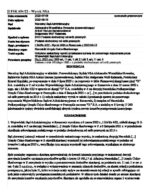
Poland vs “Sport O.B. SA”, July 2023, Supreme Administrative Court, Case No II FSK 654/22
Following a business restructuring, rights in a trademark developed and used by O.B SA was transferred to a related party “A”. The newly established company A had no employees and all functions in the company was performed by O.B. SA. Anyhow, going forward O.B SA would now pay a license fee to A for using the trademark. The payments from O.B SA were the only source of income for “A” (apart from interest). According to the O.B. group placement of the trademark into a separate entity was motivated by a desire to increase recognition and creditworthiness of the group, which was a normal practice for business entities at the time. In 2014 and 2015 O.B. SA deducted license fees paid to A of PLN 6 647 596.19 and PLN 7 206 578.24. The tax authorities opened an audited of Sport O.B. SA and determined that the license fees paid to A were excessive. To establish an arm’s length remuneration of A the tax authorities applied the TNMM method with ROTC as PLI. The market range of costs to profits for similar activities was between 2.78% and 19.55%. For the estimation of income attributable to “A”, the upper quartile, i.e. 19.55 %, was used. The arm’s length remuneration of A in 2014 and 2015 was determined to be PLN 158,888.53 and PLN 111,609.73. On that basis the tax authorities concluded that O.B. SA had overstated its costs in 2014 and 2015 by a total amount of PLN 13 583 676.17 and an assessment of additional taxable income was issued. A complaint was filed by Sport O.B. SA which was dismissed by the Administraive Court. An appeal was then filed with the Supreme Administrative Court. Judgment The Supreme Administrative Court overturned the decision and the case was referred back for reconsideration to the Administrative Court. Click here for English Translation Click here for other translation

Poland vs “E S.A.”, June 2023, Provincial Administrative Court, Case No I SA/Po 53/23
In 2010, E S.A. transferred the legal ownership of a trademark to subsidiary S and subsequently entered into an agreement with S for the “licensing of the use of the trademarks”. In 2013, the same trademark was transferred back to E. S.A. As a result of these transactions, E. S.A., between 2010 and 2013, recognised the licence fees paid to S as tax costs, and then, as a result of the re-purchase of those trademarks in 2013 – it again made depreciation write-offs on them, recognising them as tax costs. The tax authority found that E S.A. had reported income lower than what would have been reported had the relationships not existed. E S.A. had overestimated the tax deductible costs by PLN […] for the depreciation of trademarks, which is a consequence of the overestimation for tax purposes of the initial value of the trademarks repurchased from S – 27 December 2013 – by the amount of PLN […]. The function performed by S between 2010 and 2013 was limited to re-registration of the trademarks with the change of legal ownership. In the tax authority’s view, the expenses incurred by E S.A. for the reverse acquisition of the trademarks did not reflect the transactions that unrelated parties would have entered into, as they do not take into account the functions that E S.A. performed in relation to the trademarks. A tax assessment was issued where – for tax purposes – the transaction had instead been treated as a service contract, where S had provided protection and registration services to E S.A. A complaint was filed by E S.A. Judgment of the Court The Court found that there was no legal basis for re-characterisation in Poland for the years in question and that the issue should instead be resolved by applying the Polish anti-avoidance provision. On that basis, the case was referred back for further consideration. Excerpts “In principle, the tax authorities did not present any argumentation showing from which rules of interpretation they came to the conclusion that such an application of the above-mentioned provisions is legally possible and justified in the present case. It should be noted in this regard that Article 11(1) in fine speaks of the determination of income and tax due without – ‘[…] taking into account the conditions arising from the relationship…’, but does not allow for the substitution of one legal act (a licence agreement) for another act (an agreement for the provision of administration services), and deriving from the latter the legal consequences for the determination of the amount of the tax liability. There should be no doubt in this case that, in fact, the authorities made an unjustified reclassification of the legal act performed in the form of the conclusion of a valid licensing contract, when they concluded (referring to the OECD Guidelines – Annex to Chapter VI – Illustrative Examples of Recommendations on Intangible Assets, example 1, point 4) that the transactions carried out by E. and S. in fact constitute, for the purposes of assessing remuneration, a contract for the provision of trademark administration services and the market price in such a case should be determined for administration services. As the applicant rightly argued, such a possibility exists as of 1 January 2019, since Article 11c(4) uses the expression – “[…] without taking into account the controlled transaction, and where justified, determines the income (loss) of the taxpayer from the transaction appropriate to the controlled transaction”. This is what is meant by the so-called recharacterisation, i.e. the reclassification of the transaction, which is what the tax authorities actually did in the present case. At the same time, the Court does not share the view expressed in the jurisprudence of administrative courts, referring to the content of the justification of the draft amending act, according to which, the solutions introduced in 2019 were of a clarifying rather than normative nature (cf. the judgment of the WSA in Rzeszów of 20 October 2022, I SA/Rz 434/22). The applicant rightly argues in this regard that the new regulation is undoubtedly law-making in nature and that the provisions in force until the end of 2018 did not give the tax authorities such powers. It is necessary to agree with the view expressed in the literature that a linguistic interpretation of Article 11(1) of the A.p.d.o.p. and Article 11c of the A.p.d.o.p. proves that Article 11c of that Act is a normative novelty, as the concepts and premises it regulates cannot be derived in any way from the wording of Art. 11(1) u.p.d.o.p. (cf. H. Litwińczuk, Reclassification (non-recognition) of a transaction made between related parties in the light of transfer pricing regulations before and after 1.01.2019, “Tax Review” of 2019, no. 3).” “It follows from the justification of the contested decisions that, in applying Article 11(1) and (4) of the TAX Act to the facts of this case, the tax authorities referred to the OECD Guidelines, inter alia, to the example provided therein (Anex to Chapter VI – Illustrative Examples of Recommendations on Intangible Assets, example 1, point 4), from which, according to the authorities, it follows that the transactions carried out by E. S.A. and S. for the purposes of assessing remuneration constitute, in fact, a contract for the provision of trademark administration services and, in that case, the market price should be determined for such services. In this context, it should be clarified that the OECD Guidelines (as well as other documents of this organisation), in the light of the provisions of Article 87 of the Constitution of the Republic of Poland, do not constitute a source of universally binding law. Neither can they determine in a binding manner the basic structural elements of a tax, since the constitutional legislator in Article 217 of the Basic Law has subjected this sphere exclusively to statutory regulations. Since these guidelines do not constitute a source of law, they can therefore neither lead to an extension of the powers of the tax authorities nor of the
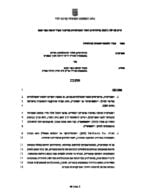
Israel vs Medtronic Ventor Technologies Ltd, June 2023, District Court, Case No 31671-09-18
In 2008 and 2009 the Medtronic group acquired the entire share capital of the Israeli company, Ventor Technologies Ltd, for a sum of $325 million. Subsequent to the acquisition various inter-company agreements were entered into between Ventor Technologies Ltd and Medtronics, but no transfer of intangible assets was recognised by the Group for tax purposes. The tax authorities found that all the intangibles previously owned by Ventor had been transferred to Medtronic and issued an assessment of additional taxable profits. An appeal was filed by Medtronic Ventor Technologies Ltd. Judgment of the District Court The court dismissed the appeal and upheld the assessment issued by the tax authorities. Click here for English translation
Switzerland vs “L-T Loan AG”, May 2023, Administrative Court, Case No SB.2023.00014 (URT.2023.24583)
“LT Loan AG” had entered into a cash pool agreement with two related parties, A Ltd. and C Ltd. According to the agreement, the interest rate on deposits in the cash pool were negative, and LT Loan AG therefor paid interest to A and C on the deposits it had in the cash pool. Following an audit the tax authority issued an assessment of additional taxable income in the form of interest on “LT Loan AG” deposits in the cash pool, set according to the Swiss Safe Harbour interest rates. “LT Loan AG” lodged a complaint or appeal with the Tax Appeals Court, which was dismissed. An appeal was then filed by “LT Loan AG” with the Administrative Court. Decision The Administrative Court upheld the decision of the Tax Appeals Court and dismissed “LT Loan AG”‘s appeal. The Swiss safe harbour rates only apply to long term loans (12 month or more). However, based on the facts of the case, the deposits in the cash pool could not be considered short term. The Safe harbour interest rates therefore applied, since “LT Loan AG” was unable to prove that the negative interest on its deposits in the cash pool were at arm’s length. Excerpt in English “6.2 As the lower court considered, the cash pooling at issue here is in principle a legal relationship that is not objectionable under civil and tax law (cf. E. 2 of the contested decision), which is reflected in the accounts in (loan) receivables of the tax payer from the cash pool or C Ltd. These receivables were recognised by the tax payer in the tax periods at issue in fixed assets (“non-current assets”); from this – expressly endorsed by the auditor of the tax payer (cf. E. 4d/ee of the contested decision) and confirmed as compliant with commercial law (cf. E. 4d/gg of the contested decision) – the lower court concluded that the accounting was in accordance with commercial law, referring to the principle of authoritativeness (see E. 4f/bb of the contested decision) that the loan receivables were acquired with the intention of long-term use or long-term holding, i. e. a period of more than twelve months (Art. 959 para. 3 sentence 2 i. V. m. Art. 960d para. 1 and 2 of the Swiss Code of Obligations [CO]; see E. 3e and 4c/aa of the contested decision). According to the lower court, the intention to hold for the long term manifested itself not only in the accounting method, but also in other respects: Firstly, it should be noted that the loans from the tax payers to C Ltd. had already existed since the 2009 financial year; in the notes to the balance sheet for the 2016 financial year, it was expressly stated with regard to the loans that the tax payer had already been participating in the cash pool system of the entire A-Group since the 2009 financial year and had receivables from the group-internal cash pools due to the “zero cash pooling principle”; In addition, it was stated there that the agreements regarding the cash pool (i.e. i.e. the legal bases under civil law) had been concluded for an indefinite period (see E. 4d/aa of the contested decision). At the end of the 2014 tax period, the cash pool holdings of the tax payers amounted to CHF …; in the 2015 financial year, a receivable from group companies of CHF … was then recognised in the balance sheet (of which CHF … from group companies). … to C Ltd. and Fr. … to A Ltd.), and in the 2016 financial year a receivable of Fr. … (of which Fr. … to C Ltd. and Fr. … to A Ltd.) (see E. 4d/cc of the contested decision). The receivables from the cash pool leaders had therefore existed for more than twelve months at the balance sheet dates for the 2015 and 2016 financial years – in line with the intentions of the tax payers – and had also existed during the year – in relation to C Ltd. with one one-day exception (see E. 4f/oo of the contested decision) – showed a consistently positive balance (see E. 4d/dd and E. 4d/ff of the contested decision). According to the lower court, the fact that a short notice period of 45 days had been agreed in the contracts between the tax payer and C Ltd. and that funds could be withdrawn at any time within three days did not change the qualification as a long-term investment. The allocation of an asset to fixed assets does not depend on its actual condition or the possibility of obtaining it under civil law through cancellation or withdrawal; rather, the purpose or the intentions of the tax payer must be taken into account. In the present case, these were aimed at long-term use, which was expressly confirmed by the auditor/auditor of the tax payer (see E. 4f/rr of the contested decision). 6.3 First of all, with regard to the considerations of the lower court, it must be pointed out that the principle of the authority of the commercial balance sheet for the question, whether a short or long-term loan exists in a specific case and whether – subsequently – the interest rates agreed between two group companies can withstand a third-party comparison. If an overall consideration of the contractual basis and the purpose of a loan suggests it, the tax authorities can and must assume a short-term loan (or, conversely, a long-term loan despite this loan being recognised in the balance sheet under fixed assets) without having to make a balance sheet amendment or balance sheet correction (in this respect, the complaint is correct, p. 11). However, since it can be assumed that an annual financial statement (certified by an auditor as compliant with commercial law) fulfils the principles of completeness, truth and verifiability (Art. 957a para. 2 items 1 and 5 CO), there must be valid reasons for such a deviation. If a company recognises a loan granted within
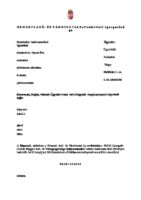
Hungary vs “Meat Processing KtF” August 2022, Directorate of Tax Appeals, Case no K.700777/2022/18 (6-KJ-2022-786)
Meat Processing KtF recorded “advance receivables” from related companies in FY 2016. The tax authority found that the invoices received by Meat Processing KtF did not contain any reference to the advance payment, the creation and repayment of the receivables were not linked to the ordering or receipt of specific goods, the payment and repayment of the “advances” had no connection with the value and purchase date of the goods purchased, the value and opening balance of the advances in 2016 and the amount deducted from the receivables exceeded the purchases made from the partner in 2016. The advance receivables were paid by bank transfers. At the beginning of 2016, Meat Processing KtF reclassified an item as an advance payment which was still recorded as a loan in its accounts at the end of 2015. Meat Processing KtF recognised an impairment loss on the advances. According to Meat Processing KtF’s statement, the purpose of the payments was related to expenses to penetrating a new market, and the accounting was used to improve the solvency of the related companies. As regards the receivables, apart from the name given, there is no indication that they were actually paid as advances on stocks. The tax authority found that the receivables were, in their true content, loans granted to the company on which not interest was paid in FY 2016. The tax authority separated 3 transactions based on the accounting records, which could not be aggregated due to the different currency denominations, and therefore priced the loan transactions separately based on the 2010 version of the OECD Transfer Pricing Guidelines, using the comparative pricing method. The minimum market interest rate for the receivable with the general ledger number 51 was set at EUR 228 670 (HUF 71 121 000), the minimum market interest rate for the receivable with the general ledger number 55 was set at EUR 19 260 (HUF 5 990 000) and the minimum market interest rate for the receivable with the general ledger number 5 was set at JPY 1 219 445 (HUF 3 065 000). On this basis, the total minimum market interest rate for receivables was set at HUF 80 176 000. As the parties did not pay interest to the taxpayer on the loans, the tax authority of first instance determined the taxpayer’s corporate tax base for 2016 in accordance with Act LXXXI of 1996 on Corporate Tax and Dividend Tax (hereinafter referred to as the Tao Act) and increased the tax liability by HUF 80 176 000 with regard to Section 18 (1) (b) of the Tax Act of 1996 (LITL), Tax Act No. 13.1 of the Tax Code. An appeal was filed with the Directorate of Tax Appeals. Decision The Directorate upheld the assessment of the first instance tax authority. Excerpt “According to point 1.64 of the 2010 version of the OECD Transfer Pricing Guidelines for Multinational Enterprises and Tax Administrations, the tax authorities’ examination of a controlled transaction should normally be based on the actual transaction carried out by the related enterprises, taking into account the way it was structured and the methods used by the taxpayer, provided that they are in accordance with the methods described in Chapter II. Except in exceptional cases, the tax administration may not disregard actual transactions or substitute other transactions. The conversion of legitimate business transactions would be an arbitrary step, the unfairness of which would be further increased if double taxation were to occur because the other tax administration did not share the views on the structure of the transaction. However, according to paragraph 1.65 of the OECD Transfer Pricing Guidelines 2010, there are two specific circumstances in which a tax administration may, exceptionally, appropriately and legitimately consider disregarding the structure used by the taxpayer at the time the controlled transaction was entered into. The first circumstance arises when the economic substance of a transaction differs from its form. In such a case, the tax administration may reject the characteristics of the transaction as provided by the parties and adapt them to the content. In both of the circumstances described above, paragraph 1.66 of the OECD Transfer Pricing Guidelines 2010 states that the characteristics of the transaction may be derived from the relationship between the parties rather than from normal commercial terms and conditions and may have been designed by the taxpayer to avoid or reduce tax. In such cases, the transaction would be based on assumptions that would not be valid if the parties were carrying out the transaction in independent circumstances. Accordingly, Article 9 allows the terms to be modified to reflect what the parties would have achieved if the parties who carried out the transaction in arm’s length circumstances had tailored the transaction to the economic and commercial realities of the situation. According to the Tax Act No. 18. § (1), if related enterprises apply a higher or lower consideration (net of VAT) in their contract or agreement between themselves than the consideration that would be valid or would be valid between independent parties in comparable circumstances (hereinafter: “arm’s length price”), the taxpayer shall, irrespective of the other items increasing or decreasing the pre-tax profit as provided for in this Act, a) reduce its pre-tax profit by an amount corresponding to the difference calculated on the basis of the arm’s length price and the consideration applied, provided that aa) as a result of the consideration applied, its pre-tax profit before tax is higher than it would have been if the arm’s length price had been applied, and (ab) the related enterprise contracting with it is a resident taxpayer or a foreign person (other than a controlled foreign corporation) subject to corporate income tax under the laws of the State of residence, and ac) has a document signed by the other party which includes the amount of the difference; b) increases (unless it is contracted with an individual who is not a sole proprietor) if the consideration paid results in a pre-tax profit before tax that
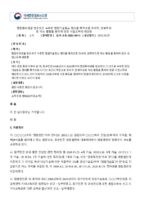
Korea vs “IP developer”, June 2022, Tax Court, Case No 2022-0014
The issue was whether “technical fees” received after a purported “transfer of patent rights” instead constituted business income – royalties – earned from continuous and recurring activities for profit and therefore subject to a higher income tax and VAT. During an audit, the tax authority found that “IP developer” had entered into a “technology transfer agreement” with a related party to transfer patent rights on four occasions between 2008 and 2020. Upon entering into the agreement, “IP developer” was to receive a “technology fee” of 5% of the annual sales of the subject technology. “IP developer” had registered a total of 78 patents, 8 design rights and 15 trademark rights, and had also entered license agreements with third parties and received income from these agreements in the form of royalty. On that basis the tax authorities considered that “IP developer” was engaged in the continuous and repeated act of licensing patent rights, and therefore the “technical fees” in question constituted business income, and the contract in question, although given the form of a transfer of patent rights, should instead be regarded as license agreement for use of patent rights. The “technical fees” received was therefore in fact royalties subject to higher tax and VAT. Judgment of the Court The Court found it reasonable to conclude that the technical fees received in exchange for the assignment of the patent rights constituted business income derived from activities carried on continuously and repeatedly, and that the payments were therefore subject to comprehensive income tax and VAT. “…In view of the above, it is difficult to conclude that it is unreasonable to expect the Claimant to declare and pay comprehensive income tax and VAT on the transfer of the patent rights at issue as business income, or that there is any justifiable reason to blame the Claimant for failing to comply with its obligations (see, e.g., Seoul Administrative Court’s judgment of 8 February 2022, 2021 No. 52112). (2) Therefore, we find no error in the decision to impose additional tax on the claimant’s failure to declare the income from the technical fee as business income and to pay the relevant comprehensive income tax and VAT.” Click here for English Translation Click here for other translation
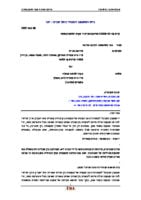
Israel vs Medingo Ltd, May 2022, District Court, Case No 53528-01-16
In April 2010 Roche pharmaceutical group acquired the entire share capital of the Israeli company, Medingo Ltd, for USD 160 million. About six months after the acquisition, Medingo was entered into 3 inter-group service agreements: a R&D services agreement, pursuant to which Medingo was to provide R&D services in exchange for cost + 5%. All developments under the agreement would be owned by Roche. a services agreement according to which Medingo was to provided marketing, administration, consultation and support services in exchange for cost + 5%. a manufacturing agreement, under which Medingo was to provide manufacturing and packaging services in exchange for cost + 5. A license agreement was also entered, according to which Roche could now manufacture, use, sell, exploit, continue development and sublicense to related parties the Medingo IP in exchange for 2% of the relevant net revenues. Finally, in 2013, Medingo’s operation in Israel was terminated and its IP sold to Roche for approximately USD 45 million. The tax authorities viewed the transactions as steps in a single arrangement, which – from the outset – had the purpose of transferring all the activities of Medingo to Roche. On that basis an assessment was issued according to which the intangibles had been transferred to Roche in 2010. Based on the acquisition price for the shares, the value was determined to approximately USD 160 millions. An appeal was filed by Medingo claiming that there had been no transfer in 2010. Judgment of the District Court The court decided in favor of Medingo and set aside the 2010 tax assessment – but without passing an opinion in relation to the value of the sale of the intellectual property in 2013. Excerpts “96. The guidelines indicate that in a transaction between related parties, two different issues must be examined using the arm’s length principle: transaction characterization and transaction pricing. The characterization of the transaction must first be examined and it must be examined whether it would also have been made between unrelated parties. If the examination reveals that even unrelated parties would have entered into a transaction in the same situation, then it must be further examined whether the price paid for the assets complies with market conditions. It should be noted that in accordance with the guidelines, the characterization of the transaction should not be interfered with in violation of the agreements, except in exceptional circumstances, in which the agreements are fundamentally unfounded, or in no way allow a price to be determined according to the arm’s length principle. “Tax A tax administration should not disregard part or all of the restructuring or substitute other transactions for it unless the exceptional circumstances described in paragraph 1.142 are met”. out circumstances in which the transaction between the parties as accurately delineated can be disregarded for transfer pricing purposes. Because non-recognition can be contentious and a source of double taxation, every effort should be made to determine the actual nature of the transaction and apply arm’s length pricing to the accurately delineated transaction, and to ensure that non-recognition is not used simply because determining an arm’s length price is difficult. e same transaction can be seen between independent parties in comparable circumstances… non-recognition would not apply… the transaction as accurately delineated may be disregarded, and if appropriate, replaced by an alternative transaction, where the arrangements made in relation to the transaction, viewed in their totality, differ from those which would have been adopted by independent enterprises behaving in a commercially rational manner in comparable circumstances, thereby preventing determination of a price that would be acceptable to both of the parties taking into account their respective perspective and the options realistically available to each of them at the time of entering into the transaction “. 97. Further to this, sections 1.146 – 1.148 of the Guideline, 2022, provide two examples of cases in which the characterization of the transaction must be ignored. The second example deals with a case closer to our case, where a one-time payment is paid for R&D services and their products provided – for 20 years. 98. After examining the characterization of the transaction in our case, I found no defect in it. This is a completely different case from those mentioned in the guidelines, and it has been proven to me that transactions with a similar characterization can be conducted and are also conducted between unrelated parties. Thus, throughout the proceedings, the appellant presented various examples of similar license agreements and R&D agreements signed between unrelated parties: In Phase A, the appellant presented various transactions for comparison (P / 2 (to which the respondent did not even refer), p. 332 of the minutes (and within the appeal Of EY Germany and of Gonen in which additional transactions were presented for comparison, including transactions of similar companies in the relevant market.” “104. I also believe that it makes sense to enter into such agreements, especially in the situation of the appellant at that time. Appellant faced considerable obstacles, and her chances of success were not guaranteed, to say the least….” “105. The inter-group agreements secured the appellant’s future in the near term, and gave her more chances to survive. As the appellant’s experts clarified, small companies find it difficult to survive alone in the medical device market (see for example Section 1 of the Michlin Opinion (hence, a licensing and commercialization agreement is common practice in the field and common with contractors with experience and resources); See also paragraph 41 regarding Broadcom).” “110. In conclusion, as long as the appellant and Roche acted in accordance with the inter-group agreements, which are acceptable in industry and in the circumstances of the case there is logic in concluding them, I did not find any invalidity in the characterization of the agreements (see paragraphs 85 and 87 in the Broadcom case).” “….As stated, I believe that even if there was an intention to transfer the activity, there was no final decision until the date of the announcement. Second, and this is the
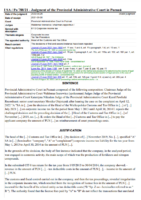
Poland vs “Fertilizer Licence SA”, April 2022, Provincial Administrative Court, Case No I SA/Po 788/21
“Fertilizer Licence SA” (“A”) transferred its trademarks to “B” in 2013, previously financed the transfer through a cash contribution, and then, following the transfer, paid royalties to “A” in exchange for the ability to use the assets. According to the tax authorities, a situation where an entity transfers its assets to another entity, finances the transfer and then pays for access to use those assets does not reflect the conditions that unrelated parties would establish. An unrelated party, in order to obtain such licence fees from another unrelated party, would first have to incur the costs of manufacturing or acquiring the trademarks and to finance these costs itself without the involvement of the licensee. An independent entity which has finances the creation or purchase of an intangible asset, should not incur further costs for the use of that asset. Furthermore, in determining the licence fee to “B” for the use of trademarks, “A” relied on formal legal ownership, granting “B” a share in the revenues generated by “A” despite the fact that “B” did not take any part in the creation of these revenues. As a result, almost all the profits of “A” were transferred as royalties to company “B”. According to the authority, such an approach is inconsistent with the arm’s length principle. The remuneration of “B” (the legal owner of trademarks) did not take into account the functions performed by entities in creating the value of trademarks nor the risks and assets involved in the creation. The authority concluded that “B” was not entitled to share in the profit of “A”, because “B” was only the legal owner of internally created trademarks in the group and performed no significant DEMPE functions, had not used significant assets nor borne significant risks. This role of “B” entitled only to reimbursement of the costs incurred for the registration and legal protection of trademarks added a arm’s length margin for this type of services. As a result of the findings, the authority of first instance concluded that “A” had overstated tax deductible costs in connection with the disclosure of trademark licence fees as costs. “A” had reported income lower than it would have expected if the above-mentioned relationships had not existed. In the opinion of the authority of the second instance, an independent entity would not have entered, on the terms and conditions set by the company and its affiliates, into transactions leading to the divestment of ownership of valuable assets necessary for its operations, additionally financing their acquisition by another company, taking up shares in return with a nominal value significantly lower than the value of the lost assets (subsequently not receiving any dividends therefrom), and additionally being forced to incur additional costs as a result of the need to pay licence fees for the use of the trademarks held earlier. An appeal was filed by “A”. Judgment of the Court Excerpts “What is important in the case, however, is the conclusion of the authorities that in fact the legal relationship justifying the incurrence of expenses recognised as tax deductible costs is a contract for the provision of services consisting only in the administration of trademarks. The Court notes, however, that this conclusion is in conflict with the position of the authorities, which did not question the validity of the legal transactions resulting in the transfer of the rights to the trade marks to company ‘B’ and thus to another entity. As the applicant rightly submits, it cannot be disregarded in this case that the applicant was not the owner of the trade marks but acquired the right to use them on the basis of a licence agreement, for which it should pay remuneration to company ‘B’ (page […] of the application). In principle, the authorities did not present any arguments showing which interpretation rules they applied to reach the conclusion that this manner of applying the abovementioned provisions is legally possible and justified in the present case. It should be pointed out here that Article 11(1) in fine speaks of the determination of income and tax due without – ‘[…] taking into account the conditions resulting from the link …’, but does not permit the substitution of one legal transaction (a licence agreement) for another (an agreement for the provision of administration services) and the derivation of legal effects from the latter in terms of determining the amount of the tax liability. As the applicant rightly argued, such a possibility exists from 1 January 2019, since Article 11c(4) uses the expression- “[…] without taking into account the controlled transaction, and where it is justified, it determines the income (loss) of the taxpayer from the transaction relevant to the controlled transaction”. This is the so-called recharacterisation, i.e. reclassification of transactions, which was actually done by the tax authorities in this case. The company’s claims that the transfer of the trade mark into a separate entity was motivated by a desire to increase the company’s recognition and creditworthiness, which was a normal practice for business entities at the time, are unconvincing. On that point, it should be noted that, operating under the GKO with the same name, the applicant’s recognition and the name under which it operated were already sufficiently well established. As regards the increase in the creditworthiness or market power of the users of the trade mark, the applicant’s contentions on this point too are empty. Moreover, even if it were to be accepted, at least in the context of the activities of ‘A’, that the creditworthiness of ‘A’ had been increased, the advantage which the applicant derives from such an operation would appear to be of little significance. In fact, it obtained this benefit to a significant extent from the formation of relations with “A”, as a result of which the value of its income taxable income, and thus its tax liability in 2015, was significantly reduced. The benefits, mainly tax ones, are also indirectly pointed out by the applicant herself, indicating, inter alia, that there were no grounds
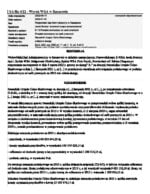
Poland vs “Sport O.B. SA”, March 2022, Provincial Administrative Court, Case No I SA/Rz 4/22
Following a business restructuring, rights in a trademark developed and used by O.B SA was transferred to a related party “A”. The newly established company A had no employees and all functions in the company was performed by O.B. SA. Anyhow, going forward O.B SA would now pay a license fee to A for using the trademark. The payments from O.B SA were the only source of income for “A” (apart from interest). According to the O.B. group placement of the trademark into a separate entity was motivated by a desire to increase recognition and creditworthiness of the group, which was a normal practice for business entities at the time. In 2014 and 2015 O.B. SA deducted license fees paid to A of PLN 6 647 596.19 and PLN 7 206 578.24. The tax authorities opened an audited of O.B. SA and determined that the license fees paid to A were excessive. To establish an arm’s length remuneration of A the tax authorities applied the TNMM method with ROTC as PLI. The market range of costs to profits for similar activities was between 2.78% and 19.55%. For the estimation of income attributable to “A”, the upper quartile, i.e. 19.55 %, was used. The arm’s length remuneration of A in 2014 and 2015 was determined to be PLN 158,888.53 and PLN 111,609.73. On that basis the tax authorities concluded that O.B. SA had overstated its costs in 2014 and 2015 by a total amount of PLN 13 583 676.17 and an assessment of additional taxable income was issued. A complaint was filed by O.B. SA. Judgment of the Court The Court dismissed the complaint of OB SA and upheld the decision of the tax authorities Excerpts “….the dependence of “A” on the applicant cannot be in any doubt. Nor can it be disputed that the abovementioned dependence – the relationship between ‘A’ and the applicant as described above – influenced the terms agreed between the parties to the licence agreement. Invoices issued by “A” to the company for this purpose amounted to multi-million amounts, and all this took place in conditions in which “A” did not employ any workers, and performed only uncomplicated administrative activities related to monitoring of possible use of the trademark by other, unauthorised entities. All this took place in conditions in which licence fees were, in principle, the main and only source of revenue for “A” (apart from interest), while the trade mark itself in fact originated from the applicant. It was also to it that the mark eventually came in 2017, after the incorporation of “A”. The company’s claims that the hive-off of the trade mark into a separate entity was motivated by a desire to increase the company’s recognition and creditworthiness, which was a normal practice for business entities at the time, are unconvincing. On that point, it should be noted that, operating under the GKO with the same name, the applicant’s recognition and the name under which it operated were already sufficiently well established. As regards the increase in the creditworthiness or market power of the users of the trade mark, the applicant’s contentions on this point too are empty. Moreover, even if it were to be accepted, at least in the context of the activities of ‘A’, that the creditworthiness of ‘A’ had been increased, the advantage which the applicant derives from such an operation would appear to be of little significance. In fact, it obtained this benefit to a significant extent from the formation of relations with “A”, as a result of which the value of its income taxable income, and thus its tax liability in 2015, was significantly reduced. The benefits, mainly tax ones, are also indirectly pointed out by the applicant herself, indicating, inter alia, that there were no grounds for the authorities to question the tax optimisations, prior to 15 July 2016. This only confirms the position of the authority in the discussed scope.” “The authority carefully selected appropriate comparative material, relying on reliable data concerning a similar category of entrepreneurs. Contrary to the applicant’s submissions, the authority analysed the terms and conditions of the cooperation between the applicant and ‘A’ when it embarked on the analysis of the appropriate estimation method in the circumstances of the case. In doing so, it took into account both the specific subject-matter of the cooperation and the overall context of the cooperation between the two entities. As for the method itself, the authority correctly found that “A” carried out simple administrative activities, and therefore took into account the general costs of management performed by this entity. In this respect it should be noted that the Head of the Customs and Tax Office accepted the maximum calculated indicator of transaction margin amounting to 19.55%. The applied method, which should be emphasised, is an estimation method, which allows only for obtaining approximate values by means of it. Moreover, it is based on comparative data obtained independently of the circumstances of the case, therefore it is not possible to adjust the results obtained on the basis of its principles by the costs of depreciation, as suggested by the applicant, alleging, inter alia, that § 18(1) of the Regulation was infringed by the authority. Moreover, the costs of depreciation of the trade mark by ‘A’ related strictly to its business and therefore did not affect its relations with the applicant. The company also unjustifiably alleges that the authority breached Article 23(3) of the Regulation by failing to take account of the economic reasons for the restructuring of its business in the context of the GKO’s general principles of operation. For, as already noted above, there is no rational basis for accepting the legitimacy of carrying out such restructuring, both in 2015 and thereafter. And the fact of the return of the trademark right to the Applicant only supports this kind of conclusion. Nor can there be any doubt as to the availability to the applicant, in 2015, of an adequate range of data relating to aspects
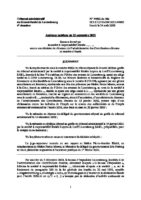
Luxembourg vs “AB SARL”, March 2022, Administrative Court, Case No 46132C
“AB SARL” had in its tax return treated mandatory redeemable preferred shares (MRPS) as debt and the payments made under the MRPS as deductible interest. The tax authorities disagreed and qualified the MRPS as equity and the payments as non-deductible dividends. On that basis an assessment was issued. Judgment of the Administrative Court The Court upheld the assessment issued by the tax authorities and qualified the mandatory redeemable preferred shares (MRPS) as equity. Click here for English translation Click here for other translation
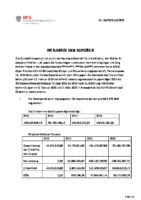
Austria vs C-Group, March 2022, Bundesfinanzgericht, Case No RV/7102553/2021
C is the parent company of the C-group which is involved in the construction business. C is part of a joint venture and for the expansion of these activities a framework agreement on shareholder loans was concluded. Under the agreement two shareholder loans were granted: ***loan*** II totalling 212,935,716.33 euros and ***loan*** III totalling 446,000,000 euros. At issue is whether (***loan*** II and ***loan*** III) are to be regarded as hidden equity capital or debt capital. In regards of loan II a binding ruling had previously been issued stating that the loan was hidden equity. C took the position that both loan II and loan III were to be treated for tax purposes as equity capital. Following an audit the tax authorities assessed both shareholder loans as debt capital and added interest income to the taxable income of C. In regards of the binding ruling previously issued, the authorities stated that the underlying facts had changed to such an extend that the ruling was no longer binding. The court of first instance held in favour of C, and an appeal was then filed by the tax authorities. Judgment of the Court The court upheld the decision of the court of first instance and found that the shareholder loans should be treated as hidden equity capital. Excerpts Loan II “Pursuant to § 118 (7) BAO, there is a legal claim that the assessment under tax law made in the information notice is used as a basis for the levying of the tax if the actual facts do not or only insignificantly deviate from those on which the information notice was based. It is certain that the complainant was issued a legally binding information notice in connection with the interest on the shareholder loan ***loan*** II. This information notice confirms that the loan granted has the character of hidden equity capital; an interest calculation for income tax purposes can therefore be omitted. It is also clear that the facts on which the tax office based the information notice have not changed. However, the tax authority now assumes that the factual elements on which the legal assessment of the information notice was based, and which were actually realised, were irrelevant for the assessment of the hidden equity in the present case.” Loan III “The separation principle is derived from the legal personality of a corporation, which allows for tax-effective service relationships between the shareholder and the corporation (cf. e.g. VwGH 28.04.2011, 2007/15/0031). The limit of the separation principle is the arm’s length principle (cf. Raab/Renner in Lachmayer/Strimitzer/Vock (eds.), Die Körperschaftsteuer (KStG 1988) (32nd ed. 2019) § 8 marginal no. 146). In connection with the granting of shareholder loans, conditions that are not arm’s length speaks in favour of hidden equity (cf. e.g. Ressler/Stürzlinger in Lang/Rust/Schuch/Staringer (eds.) KStG2 (2016) § 8 marginal no. 47). Conditions that are not customary for third parties speak against the existence of a genuine or serious shareholder loan (cf. e.g. VwGH 14.12.2000, 95/15/0127; 26.07.2006, 2004/14/0151). In the opinion of the authority concerned, only the lack of interest speaks in favour of the shareholder loan not being customary for third parties. A single indication was not sufficient to reclassify a shareholder loan as hidden equity. On the other hand, the subjective intention to repay the loan was to be regarded as the basis for the assumption that the loan was in fact debt and not equity. The fact that subjectively there was already an intention to repay at the time the shareholder loan was granted is not questioned in principle by the complainant, who himself points out in justification of the chosen model that a greater flexibility for a possible later repayment should be ensured. In addition, the chosen construction can also be explained on the basis of the company law legislation of ***Land***, according to which a repayment of equity capital is only possible in the context of a capital reduction or in the event of liquidation (cf. the legal opinion submitted on 22 February 2022). For the Federal Supreme Finance Court it is clear that the shareholder loan ***loan*** III was not granted at arm’s length (see in detail the explanations and assessment of the circumstantial evidence as part of the evaluation of the evidence). Thus, in the opinion of the Federal Fiscal Court, there is no shareholder loan to be recognised for tax purposes, but hidden equity. Since no interest is to be paid on equity capital (for tax purposes), the appeal is to be upheld on this point and the interest payment made by the authorities is to be reversed.” Click here for English translation Click here for other translation

Sweden vs Pandox AB, February 2022, Administrative Court, Case No 12512-20, 12520–12523- 20 and 13265-20
Pandox AB is the parent company of a hotel group active in northern Europe. Pandox AB’s business concept is to acquire hotel property companies with associated external operators running hotel operations. Pandox AB acquires both individual companies and larger portfolios, both in Sweden and abroad. Within the group, the segment is called Property Management. Pandox AB’s main income consists of dividends from the Property Management companies (PM companies), interest income from intra-group loans and compensation for various types of administrative services that Pandox AB provides to the Swedish and foreign PM companies. These services include strategic management, communication, general back-office functions and treasury. The PM companies’ income consists of rental income from the external hotel operators. Following an audit for FY 2013-2017 the Swedish tax authorities found that the affiliated property management entities were only entitled to a risk-free return and that the residual profit should be allocated to the Swedish parent. The tax authorities argued that Pandox AB had conducted all value-creating activities related to the core business, controlled and carried the financial risks, and actively managed the group’s business and operating agreements. The property management entities were merely legal parties in local agreements without any real control of the relevant risks. The property management entities had no employees and the boards consisted of one or two persons, most of whom were part of management at Pandox AB. Since Pandox AB controlled and managed major decisions and risks, the residual result should be allocated from the property management entities to Pandox AB. The property management entities should only be entitled to a risk-free return in line with their contributions to the value chain in accordance with paragraph 1.85 in the OECD transfer pricing guidelines. Paragraph 1.85 deals with the capability to make important business decisions. An appeal was filed by Pandox with the Administrative Court in Stockholm. Judgment of the Court The Court ruled in favor of Pandox AB. Excerpts “The Administrative Court finds that Pandox AB’s description of the operations of Property Management is strongly supported both by the documentary evidence in the cases and by what has emerged in interviews with Ms Liia Nõu. The Court also considers that the Swedish Tax Agency has not challenged the facts described by Pandox AB. Based on what has emerged from the investigation, the Administrative Court considers that Pandox AB must be regarded as having a limited role in the management of the hotel operations and a limited function in the value-creating core business. Nor does the investigation show anything other than that the PM companies independently make and implement decisions within the framework of the hotel property operations. Furthermore, the services that Pandox AB actually provides to the PM companies are priced in accordance with established transfer pricing documents, and there has been no indication that this pricing is not market-based. Even if Pandox AB, in its capacity as legal owner of the PM Companies, has the capacity and ability to renegotiate or enter into new operator agreements and make other crucial decisions for the hotel business, the investigation does not, according to the Administrative Court, show that this has been done to a particularly large extent. On the contrary, the investigation shows that Pandox AB is relatively passive after the shares in a PM company have been acquired. The Swedish Tax Agency has emphasised the management of the so-called Heart portfolio as a sign that Pandox AB actively manages the hotels in the PM companies. The Administrative Court considers, however, that the acquisition and how it was handled constitutes an exception in how Pandox AB otherwise conducts its Property Management business. Thus, the circumstance that the operator agreements were renegotiated in connection with the acquisition does not lend any more far-reaching or general conclusions about the business in general. The Administrative Court does not agree with the Tax Agency’s assessment of where in the Pandox Group the value-creating work is conducted. In this assessment, the Court takes into account in particular that the operations of the acquired PM companies are already established through, inter alia, ownership of hotel properties with associated operator agreements. Nor does the investigation provide support that Pandox AB would otherwise have had such control over the management of the hotels that the PM companies’ contribution to the business is limited in the manner described in the Tax Agency’s decision. Therefore, the Administrative Court finds that the Tax Agency’s investigation does not show that the Pandox group is based on commercial relationships as required by point 1.85 of the Guidelines. In such circumstances, the Tax Agency was not entitled to correct Pandox AB’s results in the manner recommended by the OECD Transfer Pricing Guidelines.” Click here for English Translation Click here for other translation
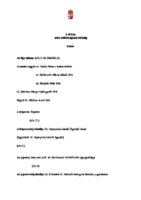
Hungary vs G.K. Ktf, December 2021, Court of Appeals, Case No. Kfv.V.35.306/2021/9
G.K. Ktf was a subsidiary of a company registered in the United Kingdom. On 29 December 2010 G.K. Ktf entered into a loan agreement with a Dutch affiliate, G.B. BV, under which G.B. BV, as lender, granted a subordinated unsecured loan of HUF 3 billion to G.K. Ktf. Interest was set at a fixed annual rate of 11.32%, but interest was only payable when G.K. Ktf earned a ‘net income’ from its activities. The maturity date of the loan was 2060. The loan was used by G.K. Ktf to repay a debt under a loan agreement concluded with a Dutch bank in 2006. The bank loan was repaid in 2017/2018. The interest paid by G.K. Ktf under the contract was deducted as an expense of HUF 347,146,667 in 2011 and HUF 345,260,000 in 2012. But, in accordance with Dutch tax law – the so called participation exemption – G.B BV did not include the interest as taxable income in its tax return. The tax authorities carried out an audit for FY 2011-2012 and by decision of 17 January 2018 an assessment was issued. According to the assessment G.K. Ktf had underpaid taxes in an amount of HUF 88,014,000. A penalty of HUF 43,419,000 and a late payment penalty of HUF 5,979,000 had been added. According to the tax authorities, a contract concluded by a member of a group of companies for a term of more than 50 years, with an interest payment condition other than that of a normal loan and without capitalisation of interest in the event of default, does not constitute a loan but a capital contribution for tax purposes. This is indicated by the fact that it is subordinated to all other creditors, that the payment of interest is conditional on the debtor’s business performance and that no security is required. The Dutch tax authorities have confirmed that in the Netherlands the transaction is an informal capital injection and that the interest paid to the lender is tax exempt income under the ‘participation exemption’. Hence the interest paid cannot be deducted from the tax base. The parties intended the transaction to achieve a tax advantage. Not agreeing with the decision G.K. Ktf took the case to court. The Court of first instance upheld the decision of the tax authorities. The case was then appealed to the Court of Appeal which resulted in the case being remanded to the court of first instance for reconsideration. After reconsidering the case, a new decision was issued in 2019 where the disallowed deduction of interest was upheld with reference to TPG 1995 para. 1.64, 1.65 and 1.66. The Court of first instance also found that the interest rate on the loan from BV was several times higher than the arm’s length interest rate. G.K Ktf then filed a new appeal with the Court of appeal. Judgment of the Court of Appeal. The Court held that the contested part of the tax authority’s decision and the final judgment of the court of first instance were unlawful and decided in favor of G.K. Ktf. For the years in question, legislation allowing for recharacterisation had still not been enacted in Hungary, and the conditions for applying the “abuse of rights” provision that was in force, was not established by the tax authorities. Click here for English translation Click here for other translation
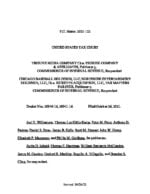
US vs Tribune Media Company, October 2021, U.S. Tax Court, T.C. Memo. 2021-122
The Internal Revenue Service found that Tribune Media Company’s subordinated debt was not bona fide debt and that its guarantees of the debt were not bona fide guarantees. Opinion of the US Tax Court The Tax Court ruled mostly in favour of the IRS and held that the subordinated “debt” should be considered equity for tax purposes. However, the court ruled in favour of Tribune Media Company with respect to the guarantees. In determining the substance of the advances, the court considered 13 factors derived from the Dixie Dairies case (74 T.C. 476 (1980): • Names given to the certificates evidencing the indebtedness • Presence or absence of a fixed maturity date • Source of payments • Right to enforce payments • Participation in management as a result of the advances • Status of the advances in relation to regular corporate creditors • Intent of the parties • Identity of interest between creditor and stockholder • “Thinness” of capital structure in relation to debt • Ability of corporation to obtain credit from outside sources • Use to which advances were put • Failure of debtor to repay, and • Risk involved in making advances In particular, the court noted that there was no fixed maturity date and no meaningful right to enforce repayment of the debt. In addition, it appeared from the facts of the case that the parties intended the subordinated debt to be treated as equity. Click here for other translation

France vs (SAS) SKF Holding France, October 2021, Conseil d’Etat, Case No. 443133
RKS, whose business consists of the manufacture of very large custom bearings for the civil and military industries, is controlled by the Swedish group SKF through (SAS) SKF Holding France. RKS was subject to a tax audit for FY 2009 and 2010, at the end of which the tax authorities adjusted the prices at which it had invoiced its products to the SKF group’s distribution companies abroad. According to the tax authorities, RKS was a simple manufacturing company that did not have control over strategic and operational risks, at therefore should not have losses resulting from such risks. As a result of the adjustment, SKF Holding France (the immediate parent of RKS) was subject to additional corporate income taxes amounting to EUR 5,385,325, including penalties. In a 2018 judgment the Montreuil Administrative Court discharged the additional taxes. However, this decision was set aside by the Versailles Administrative Court of Appeal in a judgment of 22 June 2020 in which the appeal of the tax authorities was granted. This judgment was then appealed by SKF to the Supreme Court. Judgment of the Supreme Court The Supreme Court decided in favor of SKF Holding and annulled the decision of the Versailles Administrative Court of Appeal. Excerpts from the Judgment “It is clear from the documents in the file submitted to the court that the administration applied a “transactional net margin method” (TNMM) during the audit of RKS, which consisted of comparing the ratio of net margin to turnover of this company for the transactions in question with that of eight companies operating at arm’s length and in similar fields of activity. In doing so, it found that the company’s net margin ratio was -10.46% in 2009 and -21.87% in 2010, whereas it was 2.33% in 2009 and 2.62% in 2010 for the average of the companies compared. Consequently, the administrative court of appeal was able to hold, without any error of law, that the service, at the end of this comparison, of which it noted that no criticism was addressed to it, had established a presumption of transfer of profits for the transactions in question, up to the difference between the amount of revenue recorded and that which would have resulted from the application of the average net margin rate of the panel of comparable companies. However, SKF Holding France argued before the court, in order to justify this difference, that RKS had a more important functional role than that of a simple production unit within the SKF group, which meant that it had to assume a development risk and a commercial risk and that this risk had affected its operating profit for the years in dispute. Firstly, as recommended by the OECD Transfer Pricing Guidelines, in order for it to be considered established that a company belonging to a group is in fact intended to assume an economic risk which the group’s transfer pricing policy leads it to bear, and that this policy is therefore consistent with the arm’s length principle, it is necessary for that company to have effective control and mitigation functions over that risk, as well as the financial capacity to assume it. In holding that RKS was not liable for economic losses related to the operation of its business on the sole ground that it did not have the status of ‘main contractor’ within the SKF group, without investigating whether its functional position within the SKF group was such that it could not be held liable, without investigating whether its functional position within the group gave it the right to bear the specific risks it invoked, namely, on the one hand, strategic risks linked to the choice to develop new products, and, on the other hand, operational risks linked to the efficiency of the production processes, the court vitiated its judgment with an error of law. Secondly, in holding that the negative margin rate of the company RKS was not the result of the realisation of a risk that it was intended to assume, the Administrative Court of Appeal noted that the consolidated result of the SKF group, all activities taken together, was at the same time between 6 and 14%, that the company’s purchases of raw materials had been stable and that its sales had not suffered any decrease in volume except for wind turbines. In so doing, it did not respond to the argument that SKF Holding France raised to justify the drop in RKS’s margin over the two financial years in question, according to which this company had suffered the consequences of a strategic risk linked to its choice to reorient its sole activity towards the wind power sector. It therefore vitiated its judgment by failing to state adequate reasons.” Click here for English translation Click here for other translation
Greece vs “G Pharma Ltd”, july 2020, Administrative Tribunal, Case No 1582/2020
“G Pharma Ltd” is a distributor of generic and specialised pharmaceutical products purchased exclusively from affiliated suppliers. It has no significant intangible assets nor does it assume any significant risks. However for 17 consecutive years it has had losses. Following an audit, the tax authorities issued an assessment, where the income of G Pharma Ltd was determined by application of the Transactional Net Margin Method (TNMM). According to the tax authorities a limited risk distributor such as G Pharma Ltd would be expected to be compensated with a small, guaranteed, positive profitability. G Pharma Ltd disagreed with the assessment and filed an appeal. Judgment of the Court The court dismissed the appeal of G Pharma Ltd and upheld the assessment issued by the tax authorities. Excerpts “First, the reasons for the rejection of the final comparable sample of two companies were set out in detail and then the reasons for using the net profit margin as an appropriate indicator of profitability for the chosen method of documenting intra-group transactions were documented in a clear and substantiated manner, citing the relevant OECD guidelines, in order to establish whether or not the principle of equidistance was respected. Subsequently, since the claim concerning the inclusion of the company ……………………. in the final sample of comparable companies was accepted, the calculations of the arm’s length thresholds were provided in order to assess whether or not the arm’s length principle was respected. Following the above, the method of calculation of the resulting difference due to the non-respect of the arm’s length principle in the intra-group invoicing of the applicant’s transactions with the related companies of the group was analysed. Consequently, the applicant’s claims in respect of the first plea in law of the application are not upheld and are rejected as unfounded in law and in substance. Because the applicant itself, as documented in detail in the documentation file, arrived at the above method of documentation, which it nevertheless applied on incorrect bases. The choice of the gross profit margin as an appropriate indicator of profitability is incorrect as it is not provided for in the OECD guidelines” “based on the above, it would be expected that it would be compensated with a small, guaranteed, positive profitability. Instead, the picture it presents over time is one of a company with consistently disproportionately high losses from inception to the present day beyond any notion of business sense or contrary to normal commercial transactions, which demonstrates the need to adjust its intragroup pricing given the fact that all of its purchases and a significant portion of its operating expenses are intragroup transactions. Since the applicant’s claim that ‘in calculating the adjustment to its operating profitability, due to non-compliance with the arm’s length principle, account should also be taken of the adjustments to the tax adjustment already made by the accounting differences declared by the company’ cannot be accepted and is rejected, since this is a comparison between dissimilar figures, that is to say, a comparison between the applicant’s tax result and the accounting results of comparable companies in the sample. Because the applicant’s claim that, ‘any adjustment to its operating profitability should be based on the 1st quartile value and not that of the median’, is not accepted and is rejected, as, when assessing the operating profile, the applicant performs additional functions beyond a mere reseller and in particular than the comparable companies in the final sample as it has a disproportionately high cost of operating expenses to gross income compared to the comparable companies. Moreover, none of the comparable undertakings in the final sample is representative of the industry as they all have similar gross revenues to the applicant and therefore similar market share in the pharmaceutical industry. The choice of the median is the most appropriate because it eliminates possible comparability deficits (differences in factors and circumstances) that may exist between the applicant and the undertakings in the sample. Because the tax audit has come to the clear and well-founded conclusion that the pricing policy pursued by the applicant with its related undertakings does not comply with the arm’s length principle and is outside the acceptable limits. Since it follows from the foregoing that the contested income tax assessment measure was lawfully adopted, the applicant’s claims to the contrary must be rejected as unfounded.” Click here for English translation Click here for other translation
UK vs Bluecrest Capital Management, July 2020, First-Tier Tribunal – Tax Chamber, Case No TC07782
In the case of BlueCrest Capital Management Cayman Limited (& others), the key issues involved partnership profit/loss allocations for mixed member partnerships and the associated anti-avoidance legislation – limitation on tax relief for interest on unallowable purpose loans and the sale of occupational income provisions. Judgment The Tribunal found that the sale of occupational income rules could apply to charge Income tax on partnership capital contributions. Although the arrangements did have a commercial purpose (retention and incentivization of partners), they also had as a main object the avoidance or reduction of liability to pay income tax. The test for application of the occupational income rules was therefore met.
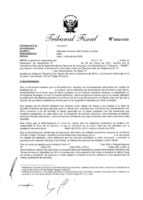
Peru vs. “P Services”, July 2020, Tax Court, Case No 03052-5-2020
“P Services! provided services to a Peruvian consortium. In 2014, the parties entered into an interest-free loan agreement. According to the loan agreement, payment for the services performed in 2013 was going to be offset against the funds received under the agreement. The tax authorities found that the “loan arrangement”, in reality constituted advances for the services provided by “P Services”- According to the authorities the arrangement had been established for the purpose of avoiding VAT on the advances received for the services. Decision of the Tax Court The tax court issued a decision in favour of the tax authorities. Click here for English translation Click here for other translation
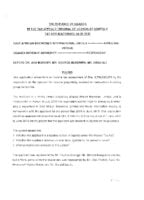
Uganda vs East African Breweries International Ltd. July 2020, Tax Appeals Tribunal, Case no. 14 of 2017
East African Breweries International Ltd (applicant) is a wholly owned subsidiary of East African Breweries Limited, and is incorporated in Kenya. East African Breweries International Ltd was involved in developing the markets of the companies in countries that did not have manufacturing operations. The company did not carry out marketing services in Uganda but was marketing Ugandan products outside Uganda. After sourcing customers, they pay to the applicant. A portion is remitted to Uganda Breweries Limited and East African Breweries International Ltd then adds a markup on the products obtained from Uganda Breweries Limited sold to customers in other countries. East African Breweries International Ltd would pay a markup of 7.5 % to Uganda Breweries and then sell the items at a markup of 70 to 90%. In July 2015 the tax authorities (respondent) audited Uganda Breweries Limited, also a subsidiary of East African Breweries Limited, and found information relating to transactions with the East African Breweries International Ltd for the period May 2008 to June 2015. The tax authorities issued an assessment of income tax of Shs. 9,780,243,983 for the period June 2009 to June 2015 on the ground that East African Breweries International Ltd was resident in Uganda for tax purposes. An appeal was filed by East African Breweries International Ltd where the agreed issues were: 1. Whether the applicant is a taxable person in Uganda under the Income Tax Act? 2. Whether the applicant obtained income from Uganda for the period in issue? 3. What remedies are available to the parties? Judgment of the Tax Appeals Tribunal The tribunal dismissed the appeal of East African Breweries International Ltd and upheld the assessment issued by the tax authorities. Excerpt “From the invoices and dispatch notes tendered in as exhibits, it was not clear who the exporter of the goods was. There was no explanation why the names of the parties were crossed out and replaced with others in some of the invoices and dispatch notes. While the applicant did not have an office or presence in Uganda it was exporting goods. In the absence of satisfactory explanations, the Tribunal would not fault the Commissioner’s powers to re-characterize transactions where there is a tax avoidance scheme. The arrangement may not only be a tax avoidance scheme but also one where the form does not reflect the substance. The markup the applicant was paying Uganda Breweries was extraordinarily low compared to what the applicant was obtaining from its sale to third partied. Once again in the absence of good reasons, the form does not reflect the substance. If the Commissioner re-characterized such transactions, the Tribunal will not fault him or her. The Commissioner cannot be said to have acted grossly irrationally for the Tribunal to set aside the decision. The Tribunal notes that the activities of the group companies were overlapping. It is not clear whether they were actually sharing TIN, premises and staff. The witness who came to testify on behalf of the applicant was from East African Breweries Limited. Despite the applicant selling goods to many countries it does not have an employee or officer to testify on its behalf. The markup of the sale of the goods by Uganda Breweries Limited to the applicant was far lower than that between the applicant and the final consumers in Sudan, Congo and Rwanda. While Uganda Breweries Limited was charging the applicant a markup of 7.5% the applicant was charging its customers 70 to 90%. This is part of a transfer pricing arrangement where the companies are dealing with each other not at arm’s length. The arm’s length principle requires inter-company transactions to conform to a level that would have applied had the transactions taking place between unrelated parties, all other factors remaining the same. Under. S. 90 of the Income Tax Act, in any transaction between associates, the commissioner may distribute, apportion or allocate income, deductions between the associates as is necessary to reflect the income realized by the taxpayer in an arm’s length transaction. An associate is defined in S. 3 of the Income Tax Act. In making any adjustments the commissioner may determine the source of income and the nature of any payment or loss. The transfer pricing arrangement originated in Uganda. The Commissioner apportion taxes according to the income received by the applicant. In Unilever Kenya Limited v CIT Income Tax Appeal No. 753/2003 (High Court of Kenya) Unilever Kenya Limited (UKL) and Unilever Uganda Limited (UUL) were both subsidiaries of Unilever PLC, a UK multinational group. Pursuant to a contract, UKL manufactured goods on behalf of and supplied them to UUL, at a price lower than UKL charged to unrelated parties in its domestic and export sales for identical goods. The Commissioner raised an assessment against UKL in respect of sales made by UKL to UUL on the basis that UKL’s sale to UUL were not at arm’s length prices. In that matter it was held that in the absence of guidelines under Kenya law, the taxpayer was entitled to apply OECD transfer pricing guidelines. In this application, the issue is not about which rules to apply. What the Tribunal can note is that the Commissioner has powers to apportion income on an intergroup company and issue an assessment. In this case the Commissioner chose the applicant over Uganda Breweries Limited. The Tribunal feels that the Commissioner was acting within his discretion and was justified to do so. Taking all the above into consideration, the Tribunal finds that the applicant did not discharge the burden placed on it to prove the respondent ought to have made the decision differently. Click here for other translation
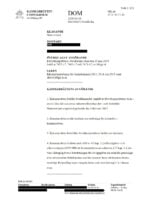
Sweden vs Datawatch AB, March 2020, Administrative Court of Appeal, Case No 4775-4777-19
D AB was accused of undervaluing its income due to internal restructuring with its U.S.-based parent company, DWC, for the tax years 2013, 2014, and 2015. The Swedish Tax Agency argued that DAB had transferred its sales activities, intangible assets, and rights to product technology to DWC without receiving appropriate arm’s length compensation, thereby reducing its taxable income in Sweden. Judgment The Court agreed with the Swedish Tax Agency, finding that D AB had indeed transferred significant assets and responsibilities, including sales, marketing, and product development functions, to DWC. DAB did not retain control over these assets after restructuring, and the actual relationship between DAB and DWC was inconsistent with the terms of their distribution agreements. Regarding compensation, the Court determined that DAB did not receive an arm’s length price for these transferred assets. The Swedish Tax Agency’s valuation, based on DWC’s acquisition cost adjusted for goodwill and other operational assets, was accepted by the Court as a fair approximation of the arm’s length value. Additionally, the Court found that DAB provided development services to DWC in 2014 and 2015, which should have been compensated at an arm’s length rate, as these services directly benefited DWC’s business. The Court upheld the decision to impose additional taxes and penalties, as DAB had submitted incorrect information on its tax returns. Excerpts in English “Based on how the business had been organized after the restructuring, it was questionable, according to the Administrative Court of Appeal, whether the company had had any opportunities to maintain these parts of the distribution agreements. According to information from the company during the audit, the agreements have not reflected how it has worked in practice. The Administrative Court of Appeal considers that the terms of the agreement differ from the parties’ actual conduct. The Administrative Court of Appeal agrees with the Swedish Tax Agency’s assessment that it is important to analyze the parties’ actual actions when determining what the actual transaction is. After the restructuring, DWC has had formal control over the company’s operations in general. According to the Administrative Court of Appeal, it is also clear that the company’s intention in connection with the restructuring was that it would cease its sales activities and that contact with customers and partners would take place at DWC. During a transitional period, certain agreements remained with the company. Without Mr. S… and the other employees of the company, DWC would not have had the competence to carry out the development activities. However, in a formal sense, it is clear that DWC has had control over the product development activities and the important decisions regarding the exploitation of the intangible assets and has had the real ability to prevent others from using the asset. It has also emerged that Mr. S.. considered that DWC made crucial strategic decisions which he considered to be manifestly bad. He also argued that, although he had a key role in the company, he had no control over the decisions. He also argued that DWC was responsible for marketing, market strategy and market risks. According to the Court of Appeal, it is also clear that the sales activities have been completely transferred to DWC.” “According to the Administrative Court of Appeal, the purchase price paid by DWC on the transfer date is a reasonable starting point for the calculation of an arm’s length price of the transferred business. The Administrative Court of Appeal considers that the valuation that led DWC to make a write-down cannot be considered to constitute an independent and commercial valuation. Moreover, the write-down in question was made more than a year after the acquisition of the company. However, in order for the purchase price to be considered a reasonable starting point for the calculation of an arm’s length price of the transferred business, it should be required that in principle all value in the company has been transferred to DWC and that no actual value has remained in the company. Otherwise, any value remaining in the company should be set off against the purchase price paid by DWC on the date of transfer. Although the company has argued that there was “know-how” in the company, it has not provided any further arguments in this respect. According to the Administrative Court of Appeal, it has not been established that there was a higher remaining value in the company to be set off against the amount in question than that calculated by the Swedish Tax Agency. The Administrative Court of Appeal considers that the arm’s length price for transferred sales activities including intangible assets and transferred rights to product technology amounts to the amount that the Swedish Tax Agency, after certain adjustments, has arrived at in its review decision” Click here for English translation Click here for other translation
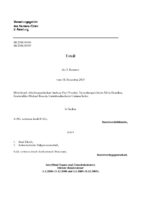
Switzerland vs Swiss Investment AG, February 2020, Administrative Court Zurich, Case No SB.2018.00094 and SB.2018.00095
Two Swiss investors had established a structure for the management of a private equity fund in the form of a Swiss “Investment Advisor” AG and a Jersey “Investment Mananger” Ltd. They each held 50% of the shares in the Swiss AG and 50% of the shares in the Jersey Ltd. Swiss AG and Jersey Ltd then entered an investment advisory agreement whereby the Swiss AG carried out all advisory activities on behalf of Jersey Ltd and Jersey Ltd assumed all the risk of the investments. Both investors were employed by Swiss AG and Jersey Ltd had no employees execpt two directors who each received a yearly payment of CFH 15,000. According to the investment advisory agreement Jersey Ltd would remunerate the Swiss AG with 66% of the gross fee income. The Swiss AG would carry out all relevant functions related to investment advisory and recommend to Jersey Ltd acquisition targets which the latter would then evaluate and subsequently decides on and assume the risk of. For provision of the advisory functions two-thirds of the total fees (of 2.25% on Assets under Management) would go to the Swiss AG, and the remaining one-third would go to the Jersey Ltd. The Swiss AG had prepared a benchmarking analysis confirming that independent private equity fund of funds (Dachfonds) earned management fees of between 0.75% and 1% on Assets under Management, which was in line with the 0.75% attributed to the Jersey Ltd. The Swiss Tax Authorities regarded the two Swiss investors employed by the Swiss AG as the only two entrepreneurs in the structure that could have possibly taken any significant decisions. On that basis the tax authorities claimed that the 66/34 profit sharing was artificial and inconsistent with the substance of the arrangements. They argued that the Jersey Ltd should only be remunerated with a cost plus 10%. This assessment was brought to the first instance of the tax appelant court and then to the administrative court. Both courts ruled that the set-up was artificial and not in line with OECD standards, after applying a substance-over-form approach. Click here for translation
Denmark vs Engine branch, January 2020, Tax Tribunal, Case No SKM2020.30.LSR
The main activity in a Danish branch of a German group was development, licensing and services related to engines that were being produced by external licensees. Under a restructuring of the group, it was decided that royalty income for a particular engine type previously received by the Danish branch should be transferred to the German company. The Danish branch received a compensation corresponding to the net earnings for a two-year notice period. The tax administration increased the taxable income of the branch claiming that the branch had made valuable contributions to the development of the type of engine in question and thereby obtained co-ownership. The Tax Tribunal found that valuable intangible assets had been transferred, The decision was based on prior contractual arrangements and conduct of the parties. Click here for other translation
Israel vs Broadcom, Aug 2019, Israeli Supreme Court, Case No 2454/19
In 2012 Broadcom Corporation acquired all the shares of Broadlight Inc, another US corporation which owned a subsidiary in Israel, for around $200 million. Three months later, the subsidiary in Israel sold its IP to a group company for $59.5m and then an agreement was entered according to which the subsidiary going forward would supply R&D, marketing and support services to the other group companies for a cost plus fee. Based on these facts the Israeli tax authorities issued an assessment equivalent to $168.5m. The tax authorities found that the full value of the company in Israel had been transferred. The tax assessment was brought to court where Broadcom claimed that the tax authorities had re-characterised the transaction and that the onus of proof was on the tax authorities to justify the value of $168.5m. The District Court held that all the values in the Israeli subsidiary had been transferred and ruled in favor of the tax authorities. This ruling was upheld by the Supreme Court. Click here for translation
Finland vs Borealis OY, March 2019, Administrative Court, Decisions not yet published
On 19 March 2019, the Helsinki Administrative Court issued two decisions in a tax dispute between the Finnish tax authorities and Borealis Polymers Oy and Borealis Technology Oy. The decisions have not been published. Borealis Polymers Oy and Borealis Technology Oy are subsidiaries of Borealis AG. The Austrian Group is a leading provider of polyolefin compounds for the global wire and cable industry, plastic materials for the automotive industry and for used in consumer products. The group also produces a wide range of base chemicals such as melamine, phenol, acetone, ethylene and propylene, as well as fertilizers and technical nitrogen products. The decisions cover fiscal years 2008, 2009 and 2010 and – according to Borealis’ public statement – relates to re-characterisation of intra group licence agreements. Additional information is providedIn Borealis’ Annual report for 2018: Borealis Technology OY, Finland, for 2008 and 2010: The reassessment decision results in an increased taxable income, leading to an additional requested payment in a total amount of EUR 297,000 thousand, consisting of additional income taxes, penalties and interests. Borealis Polymers OY, Finland, for 2009: According to the reassessment decision the taxable income increases by EUR 1 42,000 thousand, leading to an additional requested payment in a total amount of EUR 62,000 thousand, consisting of additional income taxes, penalties and interests. “Tax contingencies On 5 January 2017, Borealis received two decisions of the Finnish Board of Adjustment with regard to Borealis Technology Oy. The Board of Adjustment has confirmed the Finnish tax authority’s view that the license arrangements, entered into between Borealis Technology Oy and Borealis AG in 2008 and 2010, should be re-characterised into transfers of businesses. Based on this the Board of Adjustment requests Borealis to pay EUR 297,000 thousand, comprisingtaxes, late payment interest and penalties. Borealis believes that this decision fails to properly apply Finnish and international tax law and does not adequately consider the relevant facts of the case. Therefore, Borealis has appealed this decision to the Helsinki Administrative Court on 6 March 2017, and has obtained a suspension of payment. On 11 October 2017, Borealis received a decision of the Board of Adjustment with regard to Borealis Polymers Oy. Unlike the Finnish tax authority, the Board of Adjustment has recognised the license agreement which Borealis Polymers Oy and Borealis AG had concluded in the course of the introduction of the toll manufacturing set up in 2009. The Board of Adjustment has, however, decided that the license percentage should be increased from 1% to 2.6% and that in the course of the introduction of the toll manufacturing setup “something else of value” amounting to EUR 142,000 thousand has been transferred. The resulting payment request for the year 2009 amounts to EUR 62,000 thousand, comprising taxes, late payment interest and penalties. The decision of the Board of Adjustment did not comprise other years than 2009 and no reassessment claims for other years have been received yet. Borealis believes that this decision fails to properly apply Finnish and international tax law and does not adequately consider the relevant facts of the case. Therefore, Borealis has appealed this decision to the Helsinki Administrative Court on 15 December 2017, and has obtained a suspension of payment.Several other Borealis Group companies are currently subject to tax audits performed by their respective tax authorities. In some of the audits, specific emphasis is put on business restructuring and transfer pricing. Management’s opinion is that the Company is in compliance with all applicable regulations.“
India vs Aegis Ltd, January 2019, High Court of Bombay, Case No 1248 of 2016
Aegis Ltd had advanced money to an assosiated enterprice (AE) and recived preference shares carrying no dividend in return. The Indian Transfer Pricing Officer (TPO) held that the “acqusition of preference shares” were in fact equivalent to an interest free loan advanced by Aegis Ltd to the assosiated enterprice and accordingly re-characterised the transaction and issued an assessment for 2009 and 2010 where interest was charged on notional basis. Aegis Ltd disagreed with the assessment of the TPO and brought the case before the Tax Tribunal. The Tribunal did not accept the conclusions of the TPO. “The TPO cannot disregard the apparent transaction and substitute the same without any material of exceptional circumstances pointing out that the assessee had tried to conceal the real transaction or that the transaction in question was sham. The Tribunal observed that the TPO cannot question the commercial expediency of the assessee entered into such transaction.” The Indian Revenue Service then filed an appeal to the High Court of Bombay challenging the dicision of the Tax Tribunal. The High Court of Bombay dismissed the appeal. According to the High Court “The facts on record would suggest that the assessee had entered into a transaction of purchase and sale of shares of an AE. Nothing is brought on record by the Revenue to suggest that the transaction was sham. In absence of any material on record, the TPO could not have treated such transaction as a loan and charged interest thereon on notional basis.”
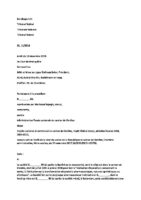
Switzerland vs R&D Pharma, December 2018, Federal Supreme Court, 2C_11/2018
The Swiss company X SA (hereinafter: the Company or the Appellant), is part of the multinational pharmaceutical group X, whose parent holding is X BV (hereinafter referred to as the parent company) in Netherlands, which company owns ten subsidiaries, including the Company and company X France SAS (hereinafter: the French company). According to the appendices to the accounts, the parent company did not employ any employees in 2006 or in 2007, on the basis of a full-time employment contract. In 2010 and 2011, an average of three employees worked for this company. By agreement of July 5, 2006, the French company undertook to carry out all the works and studies requested by the parent company for a fee calculated on the basis of their cost, plus a margin of 15%. The French company had to communicate to the parent company any discoveries or results relating to the work entrusted to it. It should also keep the parent company informed of the progress of the transactions, directly or through the Company. The results of all studies became the property of the parent company. By an agreement of February 19, 2008, the parent company granted the Swiss Company access to the research and development activities carried out by the French company, in exchange for paying the parent company a royalty of 2.5% of all revenues generated on the products or registered by the parent company through the French company. In 2013, the Swiss Tax Administration informed the Company of the initiation of a tax assessment for the years 2008 to 2010, as well as a tax evasion attempt procedure for the year 2011. These proceedings resulted from a communication from the Federal Tax Administration that mentioned the existence of charges not justified by commercial use during the years in question. Later the same year the Tax Administration informed the Company that the proceedings were extended to the years 2003 to 2007. In 2014 a tax assessment was issued for the tax years 2003 and 2005 to 2010. The Tax Administration estimated that the Company had paid royalties to the parent company for the use of research and development of certain molecules. However, the latter company had no substance or technical expertise to carry out this activity. In practice, the research and development of the X group was led by the Swiss Company, which subcontracted some of the tasks to the French company. The amount of royalties paid by the Swiss Company to the parent company, after deduction of the costs actually borne by the company for subcontracting, constituted unjustified expenses on a commercial basis. The Swiss company stated that the parent company assumes important financial, regulatory and operational risks, for which it should be compensated. The Supreme Court concluded that the parent company was a mere shell company, and as a result, disregarded the transaction. The court found that the parent did not hold the required substance to be entitle to any royalty payments. The parent was not involved in the group’s R&D activity and had no/very few employees. It was not even the legal owner because the patents were registered in the Swiss company’s name. The Swiss company had 60 employees and made all the strategic decisions over the R&D functions. The Federal Tribunal ruled in favor of the Swiss Tax Administration. The Court found the transactions and payments to be a hidden distribution of profit leading to tax evasion. Click here for English translation Click here for other translation
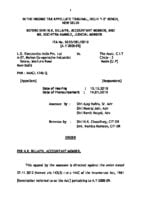
India vs L.G. Electronic India Pvt. Ltd., January 2019, Income Tax Appellate Tribunal, Case No. ITA No. 6253/DEL/2012
LG Electronic India has incurred advertisement and AMP expenses aggregating to Rs.6,89,60,79,670/- for the purpose of its business. The tax authorities undertook benchmarking analysis of AMP expenses incurred by LG Electronic India applying bright line test by comparing ratio of AMP expenses to sale of LG Electronic India with that of the comparable companies and holding that any expenditure in excess of the bright line was for promotion of the brand/trade name owned by the AE, which needed to be suitably compensated by the AE. By applying bright line test, the tax authorities compared AMP expenditure incurred by LG Electronic India as percentage of total turnover at 8.01% with average AMP expenditure of 4.93% of comparable companies. Since AMP expenses incurred by LG Electronic India as percentage of sales was more than similar percentage for comparable companies, LG Electronic India had incurred such AMP expenditure on brand promotion and development of marketing intangibles for the AE. The tax authorities also made an adjustment to the royalty rate paid to the parent for use of IP. Finally tax deductions for costs of intra-group services had been disallowed. The decision of the INCOME TAX APPELLATE TRIBUNAL In regards to the AMP expences the court states: “we are of the view that the Revenue has failed to demonstrate by bringing tangible material evidence on record to show that an international transaction does exist so far as AMP expenditure is concerned. Therefore, we hold that the incurring of expenditure in question does not give rise to any international transaction as per judicial discussion hereinabove and without prejudice to these findings, since the operating margins of the assessee are in excess of the selected comparable companies, no adjustment is warranted.” In regards to the royalty rate the court states: “we direct the TPO to determine the Arm’s Length royalty @ 4.05%” In regards to intra group services the court states: “we are of the opinion that once the assessee has satisfied the TNMM method i.e. the operating margins of the assessee are higher than those of the comparable companies [as mentioned elsewhere], no separate adjustment is warranted.”
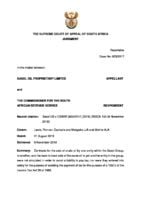
South Africa vs Sasol Oil, November 2018, Supreme Court of Appeal, Case No 923/2017
The South African Supreme Court of Appeal, by a majority of the court, upheld an appeal against the decision of the Tax Court, in which it was held that contracts between companies in the Sasol Group of companies, for the supply of crude oil by a company in the Isle of Man to a group company in London, and the on sale of the same crude oil to Sasol Oil (Pty) Ltd in South Africa, were simulated transactions. As such, the Tax Court found that the transactions should be disregarded by the Commissioner for the South African Revenue Service, and that the Commissioner was entitled to issue additional assessments for the 2005, 2006 and 2007 tax years. On appeal, the Court considered all the circumstances leading to the conclusion of the impugned contracts, the terms of the contracts, the evidence of officials of Sasol Oil, the time when the contracts were concluded (2001), and the period when Sasol Oil may have become liable for the income tax that the Commissioner asserted was payable by Sasol Oil (2005 to 2007). It held that the uncontroverted evidence of the witnesses for Sasol Oil was that in 2001, when the contracts were first concluded, the witnesses had proposed them not in order to avoid tax (residence based tax introduced in mid-2001) but because they had a commercial justification. In any event, the liability for residence based tax would have arisen only when one party to the supply agreement, resident in the Isle of Man, became a foreign controlled company in so far as Sasol Oil was concerned. That had occurred only in 2004. A finding of simulation would have entailed a finding that many individuals and corporate entities, as well as several firms of auditors, were party to a fraud over a lengthy period, for which there was no evidence at all. The Court thus found that the Commissioner was not entitled to issue the additional assessments and that Sasol Oil’s appeal to the Tax Court against the assessments should have been upheld. See the prior dicision of the Tax Court here Case 28/2018 Click here for translation
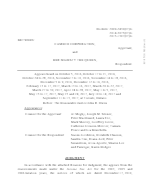
Canada vs Cameco Corp., October 2018, Tax Court of Canada, Case No 2018 TCC 195
Canadian mining company, Cameco Corp., sells uranium to a wholly owned trading hub, Cameco Europe Ltd., registred in low tax jurisdiction, Switzerland, which then re-sells the uranium to independent buyers. The parties had entered into a series of controlled transactions related to this activity and as a result the Swiss trading hub, Cameco Europe Ltd., was highly profitable. Following an audit, the Canadian tax authorities issued a transfer pricing tax assessment covering years 2003, 2005, 2006, and later tax assessments for subsequent tax years, adding up to a total of approximately US 1.5 bn in taxes, interest and penalties. The tax authorities first position was that the controlled purchase and sale agreements should be disregarded as a sham as all important functions and decisions were in fact made by Cameco Corp. in Canada. As a second and third position the tax authorities held that the Canadian transfer pricing rules applied to either recharacterise or reprice the transactions. The Tax Court concluded that the transactions were not a sham and had been priced in accordance with the arm’s length principle. The tax authorities have now decided to appeal the decision with the Federal Court of Appeal. See also Canada vs Cameco Corp, Aug 2017, Federal Court, Case No T-856-15 and Cameco’s settelment with the IRS
Hungary vs “Seeds Kft”, September 2018, Supreme Administrative Court, Curia No. Kfv. VI. 35.585/2017
The Hungarian tax office had carried out an an audit of “Seeds Kft” – a group company engaged in the trade in cereals and oilseeds – in relation to accounting for commodity futures. In the assessment decision, the tax office emphasized that the economic substance of the given transaction and the purpose to be achieved by the transaction are relevant. Clearing transactions are not settled by the delivery of the underlying commodities of the transaction and the payment of the forward price, but by financial settlement of the difference between the market price of the commodity and the forward price. With regard to the transfer pricing documentation, the tax office agreed with the pricing method chosen by Seeds Kft but found the application thereof arbitrary and therefore not resulting in establishment of a market price. The Court of First Instance found the tax office’s claim to be partly well-founded and ordered the tax authorities to reopen the proceedings. On the issue of the legal nature of the options, the court noted that, according to the expert opinion obtained in the litigation, Seeds Kft had correctly applied passive accruals and had correctly booked the transactions as clearing transactions. With regard to the transfer pricing documentation, it was noted that neither the resale price method applied by the Seeds Kft nor that of the tax office was correct. Following requests for review by both the tax office and Seeds Kft, the Court of Appeal partially set aside the judgment of the Court of First Instance and ordered the Court of First Instance to reopen the proceedings and to give a new decision. With regard to futures contracts, it was emphasized that the Court of First Instance did not rule on the issue of whether the transactions were clearing or delivery. It is not excluded that the examination of the facts necessary for deciding a particular point of law may require particular expertise, but the legal nature of the transactions cannot be inferred from the findings of experts. The valuation of legal transactions, based on accounting standards and actual implementation, is a legal issue which the expert may decide on the applicability of accruals as a professional issue. In regards to the legal nature of the contracts the Court stated that the first step was to determine whether they were correctly classified by the authority as delivery transactions and not clearing transactions. Click here for translation
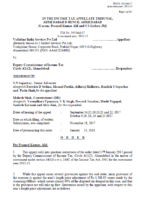
India vs Vodafone India Services Pvt Ltd, January 2018, Income Tax Appellate Tribunal, ITA No. 565/Ahd/2017
The 2018 Vodafone case from India – whether termination of option rights under an agreement can be treated as a “deemed international transaction” under section 92B(2) of the Income Tax Act. Vodafone India Services had a call option to buy shares in SMMS Investment Pvt Ltd — which held 5.11% equity capital of the Vodafone India through a web of holdings for 2.78 crore if the fair market value of these shares was less than 1,500 crore. If the fair market value was higher, it had to pay a little more. Under the same agreement, if Vodafone India Services terminated its right to acquire the share, the company would have to pay Rs 21.25 crore. Instead of exercising the call option and acquiring the valuable shares at a very low price, Vodafone India Service terminated the option and paid 21.25 crore. The tax administration held that the Vodafone India Service should have received a substantial consideration for not exercising the option. Vodafone India Services held that termination of an option was not a transaction. It also argued that it was not an international transaction, but a deal between domestic companies. The tribunal held in favor of the tax administration. The deal was deemed an international transaction. The consideration value was to be based on the price of the shares that was later sold in the market. Se also India vs Vodafone 2012

UK vs. BNP PARIBAS, September 2017, FIRST-TIER TRIBUNAL TAX CHAMBER, TC05941
The issues in this case was: Whether the price of purchase of right to dividends were deductible. Whether the purchase and sale of right to dividends was trading transaction in course of Appellant’s trade. Whether the purchase price expenditure incurred wholly and exclusively for purposes of the trade. Whether HMRC were permitted to argue point in relation to section 730 ICTA that was not raised in closure notice and which they stated they were not pursuing Whether the price of sale of right to dividends should be disregarded for the purposes of calculating Appellant’s trading profits under section 730(3) ICTA
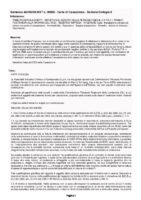
Italy vs Recordati Industria Chimica e Farmaceutica S.p.A, September 2017, Supreme Court, Case No 20805
Recordati Industria Chimica e Farmaceutica S.p.A had been issued an assessment by the tax authorities for FY 2003 on various issues related to transfer pricing. Recordati Industria Chimica e Farmaceutica S.p.A. disagreed with the assessment and brought the case to court. The Regional Tax Commission of Lombardy (Ctr) issued a decision where it partially annulled the assessment. This decision was challenged both by the tax authorities and Recordati Industria Chimica e Farmaceutica S.p.A. Judgment of the Supreme Court Before the Supreme Court there were 29 issues to be resolved. The Supreme Court predominantly ruled in favour of the tax authorities. The court confirms that transfer pricing adjustments are applicable even in the absence of proof by the administration of a concrete tax advantage by the taxpayer. The shift of taxable income following transactions between companies belonging to the same group and subject to different national regulations, does not require the administration to prove the elusive function, but only the existence of “transactions” between companies linked at an apparently lower than normal price. The court also states that it cannot be excluded that overall business strategy can induce companies to carry out uneconomic operations in view of and in function of other benefits “(…) the essential aspect of transfer pricing does not concern the justification of the lower price from an economic point of view, but whether the discounts can be considered justified from a fiscal point of view, that is, whether they respond to the principle of free competition, in accordance with the teachings of the Supreme Court.” Click here for English translation Click here for other translation
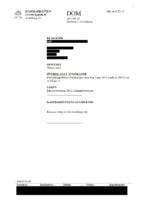
Sweden vs A AB, August 2017, Administrative Court of Appeal, Case No 6152-15
A AB appealed a Swedish Tax Agency decision regarding the income assessment for 2012, specifically around transfer pricing for the transfer of a business segment (P business) from its Swedish subsidiary, C AB, to its U.S. parent, A INC. A AB argued that only specific intellectual property assets, such as technology, a customer list, and a trademark, were transferred, rather than an entire ongoing business. It claimed the transfer price set by the Tax Agency was too high, asserting that a significant portion of the value should be attributed to Mr. X’s know-how, who continued to develop products post-transfer on behalf of A INC. The Swedish Tax Agency contended that the entire P business, including functions, risks, and key personnel like Mr. X, had been transferred, resulting in C AB being left without any assets or business activities. Judgment The Court of Appeal agreed, finding that Mr. X’s expertise was integral to the business and constituted part of the transfer, classifying the transaction as a transfer of an “ongoing concern,” or a full business unit, rather than isolated assets. Following OECD guidelines on transfer pricing, the Court supported the Tax Agency’s position that the transaction should reflect the value of an entire ongoing business, including goodwill. The Court ruled that the company’s arguments did not substantiate a lower valuation and upheld the Tax Agency’s income adjustment. Consequently, A AB’s appeal was dismissed. Click here for English translation Click here for other translation
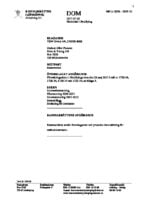
Sweden vs VSM Group AB, July 2017, Administrative Court of Appeal, Case No 2038–2041-15
An agreement between a Swedish company, VSM Group AB, and an American distributor, VSM Sewing Inc, stated that the distributor would receive compensation corresponding to an operating margin of three percent. Benchmark studies showed that the agreed compensation was arm’s length. Each year, the company made a year end adjustment to ensure that the pricing was arm’s length. In cases where the outcome was outside the interquartile range, additional invoicing took place so that the operating margin was adjusted to the agreed level. But no additional invoicing took place where the operating margin deviated from what was agreed but was within the interquartile range. The company argued that the pricing was correct as long as the operating margin was within the interquartile range. The company also argued that the agreement between the parties had a different content than the written agreement because the parties consistently applied an understanding of the arrangement that deviated from the written content. The Court of Appeal considered that the wording of the agreement was clearly formulated and lacked room for interpretation. The agreement had also been followed and the compensation had been adjusted to the agreed level in cases where additional invoicing had taken place. The mere fact that the parties deviated from the terms of the written agreement in cases where the level of compensation proved to be within the interquartile range, cannot mean that the agreement is given a different meaning, even if it has been done consistently. The Court of Appeal found that such a deviation would not have been accepted by an independent party and that it was clear that an incorrect pricing had taken place which had a negative effect on the Swedish company’s results. Click here for translation
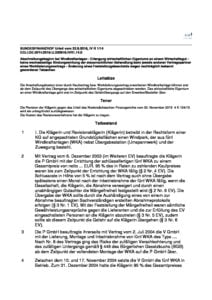
Germany vs. “Turbine Owner Gmbh”, September 2016, Supreme Tax Court IV R 1 14
Tax depreciation for wind turbines presupposes economic ownership of the asset. A change in economic ownership requires that any risks are transferred to the purchaser/customer. The German Supreme Tax Court held that economic ownership of an asset is not transferred at the time it generates income but rather when the risk of accidental destruction and accidental deterioration of the asset passes to the buyer. The contractual agreements to that effect are crucial. A German partnership (KG) operated a wind farm consisting of five wind turbines. Each wind turbine on a farm is a separate asset which is to be depreciated, or amortised, separately. In December 2003 the KG entrusted a GmbH with the turnkey construction of the turbines. The purchase price was payable in installments. The GmbH in turn engaged another company with delivery and installation of the wind turbines and also to take them into operation. According to the contract, the risk of accidental destruction and accidental deterioration of the turbines should not pass before installation was completed. The turbines were first put into operation in November 2004. In September 2005 the wind turbines were inspected and accepted by the GmbH. The KG wished to depreciate the turbines from November 1, 2004 based on a useful life of 16 years. The tax office declined and demanded depreciation to begin from September 2005. This was confirmed by the Supreme Tax Court. Although possession of the turbines was with the KG as early as November 2004 and the KG took advantage (use) of the turbines already from that day, the underlying insurance contract provided coverage to start not before acceptance of the turbines. The court went on to point out that the supplier of the asset still had to bear the risks until final acceptance, namely in the event of technical problems which might occur during the trial operation of the wind turbines. That payment of the full purchase price was made as early as December 2004 did not have an impact on the economic ownership and hence not influence the judgment of the court. Click here for English translation Click here for other translation
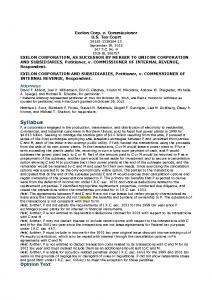
US vs. Exelon Corp, September 2016, US Tax Court
The case was about a sale and lease back arrangement characterizised as a loan by the US tax authorities referring to “substance over form”. The Court agreed with the tax authorities. “We have held that all of the test transactions failed the substance over form inquiry because petitioner did not acquire the benefits and burdens of ownership in the assets involved in the test transactions. We have also concluded that the test transactions are more similar to loans made by petitioner to CPS and MEAG because petitioner’s return on its investment was predetermined at the time petitioner entered into the test transactions. Accordingly, in 1999 petitioner exchanged the Powerton and Collins power plants for an interest in financial instruments. Such an exchange fails to meet the “like kind” requirement outlined in the Code and the regulations. Thus, petitioner must recognize the gain it received in 1999 on the sale of the Powerton and Collins plants under section 1001.”
Malaysia vs Ensco Gerudi, June 2016, High Court, Case No. 14-11-08-2014
Ensco Gerudi provided offshore drilling services to the petroleum industry in Malaysia. The company did not own any drilling rigs, but entered into leasing agreements with a rig owner within the Ensco Group. One of the rig owners in the group incorporated a Labuan company to facilitate easier business dealings for the taxpayer. Ensco Gerudi entered into a leasing agreement with the Labuan company for the rigs. Unlike previous transactions, the leasing payments made to the Labuan company did not attract withholding tax. The tax authorities found the Labuan company had no economic or commercial substance and that the purpose of the transaction had only been to benefit from the tax reduction. The High Court decided in favour of the taxpayer. The Court held that there was nothing artificial about the payments and that the transactions were within the meaning and scope of the arrangements contemplated by the government in openly offering incentives. The High Court ruled that taxpayers have the freedom to structure transactions to their best tax advantage in so far as the arrangement viewed in a commercially and economically realistic way makes use of the specific provision in a manner that was consistent with Parliament’s intention.
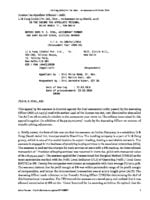
India vs Li & Fung (Trading) Ltd. March 2016, Income Tax Appellate Tribunal, ITA No. 386/Del/2014
Li & Fung (Trading) Ltd., Hong Kong, entered into contracts with its global third party customers for provision of sourcing services with respect to products to be sourced by such global customers directly from third party vendors in India. For the sourcing services, the Hong Kong company received a 5% commission of the FOB value of goods sourced. The company in India was providing sourcing support services to the Hong Kong group company, and remunerated at cost plus 5 percent mark-up for provision of these services. The tax administration found that the the company in India should get the 5% commission on the free on board (FOB) value of the goods sourced from India as the Hong Kong company contributed no value. The Tribunal held that the compensation received by the company in Hong Kong – 5% of the FOB value – should be distributed between the company in India and the company in Hong Kong in the ratio of 80:20 based on there functional profiles. • The company in India had actually performed all critical functions, assumed significant risks and had also developed unique intangibles over the years. • The company in Hong Kong did not have either any technical expertise or manpower to carry out the sourcing activities. Se also India vs Li & Fung 2013 and India vs Li & Fung 2011
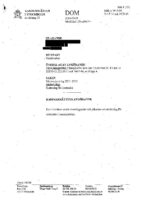
Sweden vs AB bioMérieux, March 2016, Administrative Court of Appeal, Case No 7416-14
AB bioMérieux had entered into a trademark and know-how licensing agreement, followed by a reduction of its activities and a transfer of strategic personnel to its French parent company. The tax authorities concluded that the entire arrangement constituted a transfer of value (intangible assets) and issued a notice of additional taxable income resulting from the transfer. AB bioMérieux filed an appeal which ended up in the Administrative Court of Appeal. Judgment The court upheld the assessment of the tax authorities. It found that AB bioMérieux became the formal legal owner of the intangible assets, while the value (intangible assets related to the ongoing business) was transferred to the French parent company. Excerpt in English “Initially, based on the wording of the licence agreement and the legal opinions issued by the professors………………………………………………, the Administrative Court of Appeal cannot find sufficient reasons to consider that the agreement in itself is something other than a licence agreement under civil law. Thus, the licence agreement as such alone does not constitute grounds for departing from the parties’ characterisation of the agreement itself as a licence agreement. However, when assessing which transaction has been undertaken between the parties, all of the parties’ dealings must be taken into account (cf. paragraph 1.52 et seq. of the OECD Guidelines). Similarly, there may be reasons to disregard the parties‘ designation of the transaction in the case where a transaction is indeed the same in form and content, but where the parties’ other dealings in relation to the transaction, viewed as a whole, differ from those that would have applied between independent traders acting in a commercial and rational manner (paragraph 1.65 of the Guidelines). In addition to the written licence agreement, the actual circumstances and the parties‘ intention as well as the economic significance of the parties’ combined conduct must therefore also be taken into account. The Administrative Court of Appeal considers, as does the Administrative Court, that it cannot be considered consistent with the arm’s length principle to isolate the licence from the parties’ other dealings during the period from the share acquisition in June 2008 to the licence in July 2010. The Administrative Court of Appeal further agrees with the Administrative Court’s assessment that the actual circumstances are best described as a restructuring. Prior to the share acquisition in 2008, the company was a fully fledged company, which meant that the company itself developed, manufactured, marketed and sold its products. In addition to the exclusive licence that the company granted to …………. under the licence agreement, the company gradually ceased its activities relating to research and development, manufacturing, marketing, sales and distribution of ……………….. during 2008-2010, while …………. was given the opportunity to conduct the same activities. Following the expiry of the licence agreement, the company retains only the ownership of the know-how and trade marks relating to………….. The licence agreement clearly regulates the assignment of the intellectual property rights between the parties for a fixed period. Furthermore, it is clear that, even taking into account that no unit or branch of activity has been transferred from the company to the parent company, the restructuring in its entirety means that the company has relinquished the functions linked to the …………… and …………….. products in favour of the parent company. It is also apparent from the documents in the cases that two persons who have been the bearers of the know-how that the licence agreement is intended to regulate have terminated their employment in the company in order to work for a certain period of time in the parent company for the purpose of incorporating know-how relating to …………….. The Administrative Court of Appeal further finds that the financial risk associated with functions and activities linked to has essentially been transferred to the parent company. According to what has emerged, it is …………… that ties up capital, carries out investments for research and development and bears all operational risks, e.g. linked to production, damages, etc. This assessment is also well in line with points 9.188-9.189 of the guidelines. The gradual winding down of the company’s operations and the start-up of the same operations together with the licence agreement has thus entailed a transfer of value in that assets, functions and risks linked to ——— have been transferred to ……………….. (cf. ongoing concern, paragraph 9.93 of the OECD Guidelines). The entire reorganisation and the resulting transfer of value should therefore be regarded as one transaction. In the opinion of the Court of Appeal, the transaction that should form the basis for the continued assessment is thus the transfer of research and development, manufacturing, marketing, sales and distribution of Etest, as well as the licensing of know-how and trademarks linked to …………… for a period of ten years.” Click here for English translation Click here for other translation
![UK vs UBS AG, March 2016, Supreme Court, Case No [2016] UKSC 13](https://tpguidelines.com/wp-content/uploads/UK-vs-USB-AG-uksc-judgment-pdf-image-141x200.jpg)
UK vs UBS AG, March 2016, Supreme Court, Case No [2016] UKSC 13
In this case the UK Supreme Court addressed the Ramsay approach, when it considered tax avoidance schemes which involved composite transactions designed to avoid payment of income tax on bankers’ bonuses. According to the Supreme Court the Ramsay case did not develop a special rule for tax avoidance schemes; instead it extended to tax cases the purposive approach to statutory construction which was orthodox in other areas of the law. The Ramsay principle established that the analysis of the facts depended upon the purposive construction of the statute. While this was not a new special rule for tax avoidance cases, the approach had proved particularly important in such cases. Excerpts from the Supreme Court Judgment “The Ramsay approach 61. As the House of Lords explained in Barclays Mercantile Business Finance Ltd v Mawson, in a single opinion of the Appellate Committee delivered by Lord Nicholls, the modern approach to statutory construction is to have regard to the purpose of a particular provision and interpret its language, so far as possible, in the way which best gives effect to that purpose. Until the case of W T Ramsay Ltd v Inland Revenue Comrs [1982] AC 300, however, the interpretation of fiscal legislation was based predominantly on a linguistic analysis. Furthermore, the courts treated every element of a composite transaction which had an individual legal identity (such as a payment of money, transfer of property, or creation of a debt) as having its own separate tax consequences, whatever might be the terms of the statute. As Lord Steyn said in Inland Revenue Comrs v McGuckian [1997] 1 WLR 991, p 999, in combination those two features – a literal interpretation of tax statutes, and an insistence on applying the legislation separately to the individual steps in composite schemes – allowed tax avoidance schemes to flourish to the detriment of the general body of taxpayers. 62. The significance of the Ramsay case was to do away with both those features. First, it extended to tax cases the purposive approach to statutory construction which was orthodox in other areas of the law. Secondly, and equally significantly, it established that the analysis of the facts depended on that purposive construction of the statute. Thus, in Ramsay itself, the terms “loss” and “gain”, as used in capital gains tax legislation, were purposively construed as referring to losses and gains having a commercial reality. Since the facts concerned a composite transaction forming a commercial unity, with the consequence that the commercial significance of what had occurred could only be determined by considering the transaction as a whole, the statute was construed as referring to the effect of that composite transaction. As Lord Wilberforce said: “The capital gains tax was created to operate in the real world, not that of make-belief. As I said in Aberdeen Construction Group Ltd v Inland Revenue Comrs [1978] AC 885, it is a tax on gains (or I might have added gains less losses), it is not a tax on arithmetical differences. To say that a loss (or gain) which appears to arise at one stage in an indivisible process, and which is intended to be and is cancelled out by a later stage, so that at the end of what was bought as, and planned as, a single continuous operation, there is not such a loss (or gain) as the legislation is dealing with, is in my opinion well and indeed essentially within the judicial function.” (p 326) 63. “Unfortunately”, the Committee commented in Barclays Mercantile at para 34, “the novelty for tax lawyers of this exposure to ordinary principles of statutory construction produced a tendency to regard Ramsay as establishing a new jurisprudence governed by special rules of its own”. In the Barclays Mercantile case the Committee sought to achieve “some clarity about basic principles” (para 27). It summarised the position at para 32: “The essence of the new approach was to give the statutory provision a purposive construction in order to determine the nature of the transaction to which it was intended to apply and then to decide whether the actual transaction (which might involve considering the overall effect of a number of elements intended to operate together) answered to the statutory description. … As Lord Nicholls of Birkenhead said in MacNiven v Westmoreland Investments Ltd [2003] 1 AC 311, 320, para 8: ‘The paramount question always is one of interpretation of the particular statutory provision and its application to the facts of the case.’” As the Committee commented, this is a simple question, however difficult it may be to answer on the facts of a particular case. 64. This approach has proved to be particularly important in relation to tax avoidance schemes as a result of two factors identified in Barclays Mercantile at para 34. First, “tax is generally imposed by reference to economic activities or transactions which exist, as Lord Wilberforce said, ‘in the real world’”. Secondly, tax avoidance schemes commonly include “elements which have been inserted without any business or commercial purpose but are intended to have the effect of removing the transaction from the scope of the charge”. In other words, as Carnwath LJ said in the Court of Appeal in Barclays Mercantile, [2002] EWCA Civ 1853; [2003] STC 66, para 66, taxing statutes generally “draw their life-blood from real world transactions with real world economic effects”. Where an enactment is of that character, and a transaction, or an element of a composite transaction, has no purpose other than tax avoidance, it can usually be said, as Carnwath LJ stated, that “to allow tax treatment to be governed by transactions which have no real world purpose of any kind is inconsistent with that fundamental characteristic.” Accordingly, as Ribeiro PJ said in Collector of Stamp Revenue v Arrowtown Assets Ltd [2003] HKCFA 46; (2003) 6 ITLR 454, para 35, where schemes involve intermediate transactions inserted for the sole purpose of tax avoidance, it is quite likely that a purposive interpretation will result in such steps being
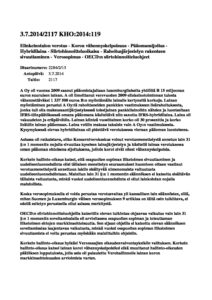
Finland vs. Corp, July 2014, Supreme Administrative Court, KHO2014:119
A Ab had in 2009 from its majority shareholder B, based in Luxembourg, received a EUR 15 million inter-company loan. A Ab had in 2009 deducted 1,337,500 euros in interest on the loan. The loan had been granted on the basis that the banks financing A’s operations had demanded that the company acquire additional financing, which in the payment scheme would be a subordinated claim in relation to bank loans, and by its nature a so-called IFRS hybrid, which the IFRS financial statements were treated as equity. The loan was guaranteed. The fixed annual interest rate on the loan was 30 percent. The loan could be paid only on demand by A Ab. The Finnish tax authorities argued that the legal form of the inter-company loan agreed between related parties should be disregarded, and the loan reclassified as equity. Interest on the loan would therefore not be deductible for A Ab. According to the Supreme Administrative Court interest on the loan was tax deductible. The Supreme Administrative Court stated that a reclassification of the loan into equity was not possible under the domestic transfer pricing provision alone. Further, the Supreme Administrative Court noted that it had not been demonstrated or even alleged by the tax authorities that the case was to regarded as tax avoidance. The fact that the OECD Transfer Pricing Guidelines (Sections 1.65, 1.66 and 1.68) could in theory have allowed a reclassification of the legal form of the loan into equity was not relevant because a tax treaty cannot broaden the tax base from that determined under the domestic tax provisions. Consequently, the arm’s length principle included in Article 9 of the tax treaty between Finland and Luxembourg only regarded the arm’s length pricing of the instrument, not the classification of the instrument. Click here for other translation
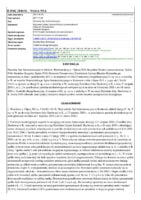
Poland vs “H-S Goods S.A.”, October 2013, Supreme Administrative Court, Case No II FSK 2840/11
“H-S Goods S.A.” was active in wholesale trade of heating and sanitary goods. The main supplier of the products was a related company from Germany, and the cusomers/recipients of the goods were both unrelated domestic companies and foreign related companies (in Latvia and Ukraine). Approximately 30 % of sales were to related parties. Sales prices for the controlled transactions, were determined based on the purchase prices from the supplier. “H-S Goods S.A.” argued that transactions with the related parties were not sale of goods, but rather provision of warehousing services on behalf of the related German supplier. For these services “H-S Goods S.A.” received a 5% margin. The tax authorities found that the activities and the fact that legal title to the goods was transferred to “H-S Goods S.A.”, meant that the transaction was in fact distribution of goods. Furthermore, the margins obtained by “H-S Goods S.A.” from sale of goods to unrelated customers was considerably higher than the 5% margins obtained from sales to related parties. A complaint was filed by “H-S Goods S.A.” with the Administrative Court which was unsuccessful. According to 2011 decision from the Administrative Court , the tax authorities had proven that the margin on goods sold to unrelated customers was considerably higher than the margin obtained from sales to related parties. The court also agreed that the activities of “H-S Goods S.A.” could not be considered warehousing services. An appeal was then filed by “H-S Goods S.A.” with the Supreme Administrative Court. Judgment of the Court The Court upheld the decision of the court of first instance. Excerpts “The Supreme Administrative Court held as follows: 7. the cassation appeal has no justified grounds. Pursuant to Article 174 of the P.p.s.a., a cassation appeal may be based on the following grounds: (1) infringement of substantive law through its misinterpretation or misapplication; (2) infringement of procedural provisions, if this infringement could have had a significant impact on the outcome of the case. The Supreme Administrative Court, in connection with Article 183 § 1 of the P.p.s.a., considers the case within the limits of the cassation appeal, taking into account ex officio only the invalidity of the proceedings. Binding of the Court to the grounds of the cassation complaint requires that they are correctly specified in the complaint itself. This means that it is necessary to cite the specific provisions of law which the court has violated, to substantiate the allegation of their violation and, if a violation of procedural law is alleged, to demonstrate additionally that this violation could have had a significant impact on the outcome of the case. As regards substantive law, it is necessary to demonstrate what the misinterpretation or misapplication by the court of first instance consisted of and what the correct interpretation or application of the substantive law provision should have been. Similarly, in the case of an infringement of procedural law, it is necessary to indicate the provisions of that law infringed by the court, what the infringement of those provisions consisted in and why that infringement could have had a significant impact on the outcome of the case. When the cassation appeal alleges both a violation of substantive law and a violation of procedural law, the last-mentioned allegation is examined first. Only after it has been determined that the state of facts adopted by the court in the appealed judgment is correct or has not been effectively challenged, may one move on to control the process of subsumption of the given state of facts under the provision of substantive law applied in the case. (cf. the judgment of the Supreme Administrative Court of 19 February 2008, II FSK 1787/06, unpublished). In the present case, the appellant only raises allegations of infringement of procedural provisions, since the content of the plea I named as the allegation of violation of substantive law in fact indicates only circumstances of procedural nature, such as: “erroneous assumption by the Court of First Instance that the most appropriate method of estimating income in transactions with related parties is the transaction margin method”. Meanwhile, a possible incorrect legal assessment of the factual state does not constitute a violation of substantive law and, as such, cannot constitute a cassation ground within the meaning of Article 174(1) of the A.P.S.A. An assessment of the legitimacy of the application of substantive law, i.e. Article 11(3) of the A.P.D.O.P. in conjunction with § 4(4), § 11(1) and (2) and § 12(1) and (2) of the Ordinance may only be made on the basis of correctly established facts. Incorrect application of the law consists of the so-called error in subsumption, which is expressed in the fact that the facts established in the case were erroneously deemed to correspond to the hypothetical state provided for by the legal norm, or that the established facts were erroneously not “drawn” under the hypothesis of a specific legal norm. Thus, the application of the substantive law is the correct reference of the substantive law norm to the established state of facts, i.e. the correct confrontation of the circumstances of the state of facts with the hypothesis of the legal norm and the submission of this state of facts to a legal assessment on the basis of the content of this norm. Hence, the defects raised by the author of the cassation complaint may be challenged only under the second ground of the cassation complaint – Article 174(2) of the Code of Civil Procedure.” “Allegation II, point 1 is not justified. Contrary to the arguments of the appellant, the court of first instance, following the guidelines contained in the judgment of the Supreme Administrative Court of 1 March 2011, correctly determined the nature of the transaction between the taxpayer and related entities. In particular, it referred to the amount of the established 5% margin, indicating at the same time that the margin imposed on goods intended for sale on the Polish market was on average 6 times higher than the established compensatory margin.” Click here for
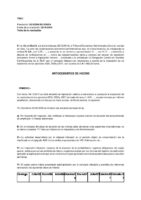
Spain vs “X Beverages S.A.”, October 2013, TEAC, Case No 00/02296/2012/00/00
“X Beverages S.A.” had entered into an agreement with the ABCDE Group for the use of concentrate and trademarks for the production and sale of beverages in Spain, but according to the agreement, “X Beverages S.A.” only paid for the concentrate. Following an audit for the financial years 2005-2007, the tax authorities issued an assessment which considered part of the payment to be royalties on which withholding tax should have been paid. Court’s Judgment The Court agreed that part of the payment could be qualified as royalties, but the assessment made by the tax authorities had been based on secret comparables – leaving the taxpayer defenceless – and on this basis the Court annulled the assessment. Excerpts “The taxpayer itself seems to recognize that the so-called “Contract of …” contains both a distribution contract and a trademark assignment contract when it says on page 127 of its statement of allegations “Indeed, this authorization of use is necessary to be able to carry out the activity of packaging and distribution that is the object of the contract, and it would not be possible for X to carry out its obligations under the contract if it did not have this authorization to use the trademark. If X did not have the right to use the trademark, it would not be able to package and label the product as required by its principal (Z), nor would it be able to distribute it under said trademark, in accordance with the terms of the contract.” And although the “authorization of use” of the trademark recognized by the taxpayer is qualified by the latter as an obligation and not as a right of the same, seeming to want to reach the conclusion that only if it were a right it would generate a royalty, in the opinion of this Court both aspects (obligation and right) are not mutually exclusive but complementary: X acquires the right to use the trademark and the obligation to use the same with respect to the products (the beverages) made by it with the “concentrates” acquired from the ABCD Group. And without the existence of limits and/or conditions. Limits and/or conditions which, on the other hand, are inherent to any assignment of rights contract, which is never absolute. In the present case, such limits would be that X may not use the trademark to identify other products not made with the “concentrates” purchased from the ABCD Group and that it may not identify the products made with such “concentrates” under another trademark. Both things are logical since the trademark owner remains the owner of the trademark (he only assigns its use in a certain temporal and territorial scope) and must protect its prestige by means of the indicated precautions (previously called limits and/or conditions). Por otro lado, y en contra de lo alegado (pág. 129 of the pleadings), the right to use the trademark is not something merely “instrumental” but something “substantial” to the contracts entered into between the parties in the sense that it is in the interest of the supplier to sell its concentrates and of X to market the products it manufactures with such concentrates under certain trademarks (ABCD or M8), of special diffusion and prestige in the market and whose use implies a volume of sales notably higher than that which it would obtain if it marketed the products under X ‘s own denomination without such diffusion and prestige in the market. The importance of the trademark is such (and more so the ones we are now dealing with) that it would be difficult to understand in the opinion of the Inspectorate a purely “instrumental” transfer of use of the same, and much less free of charge, as the claimant defends. This circumstance is supported by the Inspection in the Valuation Report, which grants to the assignment of the trademark, as an example, percentages of 61.17% of the price of the concentrate in the case of ABCD-1 and 46.18% in the case of ABCD-2.” “Thus, it is clear that the promotion of the ABCD trademark in Spain (not of the products themselves, which is what is made with the “concentrates” acquired by X) generates expenses for the holder of the trademark[2] ( ABCD Group and, specifically,ABCD C…), the inspection revealed that “it does not seem reasonable to think that the ABCD trademarks in Spain only generate expenses and no income” (….) “From a strictly economic perspective, the actions of the ABCD group, assuming such an amount of expenses to make the brand known to the consumer without this action generating any income for the brand in Spain, lacks all rationality”. This is an additional fact taken into account by the Inspectorate for the purpose of confirming the rationality of the fact that the assignment of use of the trademark is not free of charge but that the ABCD Group obtains income from it.” “In the case at hand, we cannot properly speak of “lack of evidence” but more properly of “lack of externalized evidence” since, even if such evidence exists (which this Court, in principle, has no doubt about), it cannot be incorporated into the file that is made available to the interested party, Therefore, the latter is defenseless when it comes to being able to oppose the suitability of the comparables used, so that, as stated in the previously transcribed SAN, we are faced with an “inadequate assessment method” in terms of generating defenselessness in the taxpayer. This Central Court has recently pronounced in the same sense as above in its RG of 05-09-2013 (RG 3780/11). Having said the above with respect to the “subjective motivation”, it should be noted that the objections raised by the taxpayer with respect to the “technical motivation” refer basically to the fact that the data used by the Inspection to assess are not in any case comparable with those of ABCD because ABCD is unique and neither by its product characteristics, nor by the characteristics of the product …. . In
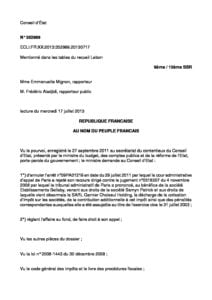
France vs SARL Garnier Choiseul Holding, 17 July 2013, CE No 352989
This case is about the importance of proving that the transaction has a real economic purpose, and that it does not artificially seek to achieve tax benefits. The courts also consider the spirit of the law, for example, the purpose of the tax exemptions relating to parent-subsidiary distributions is to involve the parent company in the business of the subsidiary. Click here for translation
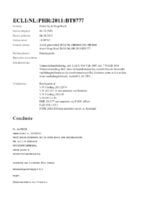
Nederlands vs “Paper Trading B.V.”, October 2011, Supreme Court, Case No 11/00762, ECLI:NL:HR:2011:BT8777
“Paper Trading B.V.” was active in the business of buying and selling paper. The paper was purchased (mostly) in Finland, and sold in the Netherlands, Belgium, France, and Germany. The purchasing and selling activities were carried out by the director of Paper Trading B.V. “Mr. O” who was also the owner of all shares in the company. In 1994, Mr. O set up a company in Switzerland “Paper Trader A.G”. The appointed director of “Paper Trader A.G” was a certified tax advisor, accountant, and trustee, who also acted as director of various other companies registered at the same address. The Swiss director took care of administration, correspondence, invoicing and corporate tax compliance. A couple of years later, part of the purchasing and selling of the paper was now carried out through “Paper Trader A.G”. However, Mr. O proved to be highly involved in activities on behalf of “Paper Trader A.G”, and the purchase and sale of its paper. Mr. O was not employed by “Paper Trader A.G”, nor did he receive any instructions from the company. From witness statements quoted by the Court in the context of a criminal investigation, it followed that Mr. O de facto ran “Paper Trader A.G” like Paper Trading B.V. Mr. O decided on a case-by-case basis whether a specific transaction was carried out by either one of the companies. Moreover, both companies had the same suppliers of paper, paper products, logistics providers and buyers. The only difference was the method of invoicing and payment. The tax authorities issued additional corporate income tax assessments for fiscal years 1996, 1997 and 1998. For fiscal year 1999, the tax authorities issued a corporate income tax assessment that deviated from the corporate income tax return filed by Paper Trading B.V. These decisions were appealed at the Court of Appeal in Amsterdam (the Court). Ruling The Court considered it plausible that the attribution of profit was not based on commercial consideration, but motivated by the interest of the Mr O. The aim was to siphon a (large) part of the revenue achieved from trading activities from the tax base in the Netherlands. The Court of Appeal ruled that the income generated by Paper Trader A.G had to be accounted for at the level of the Paper Trading B.V. For administrative services, Paper Trader A.G was entitled to a cost plus remuneration of 15%. Certain expenses could not be included in the cost basis, such as factoring and insurance fees. Judgment of the Supreme Court The Supreme Court confirmed the ruling. Click here for English translation Click here for other translation
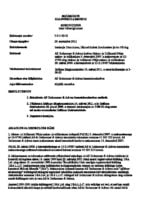
Estonia vs AS Technomar & Adrem, September 2011, Supreme Court, Case No 3-3-1-42-11
Following an audit the tax authorities assessed a significant income tax liability on AS Technomar & Adrem, arguing that the company had used offshore entities (T&A Ltd. Isle of Man and T&A L.L.C. Utah, USA) to shift profits and evade taxes. The tax authorities deemed these foreign entities as controlled by AS Technomar & Adrem and concluded that their transactions were artificial. The tax authorities contended that T&A Ltd. and T&A L.L.C. acted merely as intermediaries, reselling goods at higher prices to AS Technomar & Adrem or purchasing goods from it and selling them at inflated prices to third parties. The price difference was considered a hidden profit of AS Technomar & Adrem. The authorities justified the tax assessment under § 84 of the General Tax Code, which allows the recharacterization of artificial arrangements made for tax avoidance. AS Technomar & Adrem challenged the decision, arguing that the tax authorities wrongfully attributed the offshore companies’ income to them. The company maintained that T&A Ltd. and T&A L.L.C. were legally independent entities, and transactions between them were legitimate. The company further argued that transfer pricing rules (specifically § 50(4) of the Income Tax Act) should have been applied instead of § 84 of the Tax Code, as transfer pricing provisions would only allow taxation of the price differences rather than attributing all income to AS Technomar & Adrem. The Tallinn Administrative Court upheld the tax authority’s decision, ruling that the offshore companies were not independent and acted solely for AS Technomar & Adrem’s benefit. The court found that transfer pricing provisions did not apply because there was no actual transfer of profits between independent entities—rather, the offshore companies were merely an extension of the Estonian company. AS Technomar & Adrem appealed to the Tallinn Circuit Court, which again upheld the tax ruling, rejecting arguments about procedural violations, the limitation period, and previous tax authority decisions that had not imposed tax on similar transactions. Judgment of the Supreme Court The Supreme Court partially upheld the company’s appeal. While the court agreed that § 84 of the Tax Code was applicable and that AS Technomar & Adrem engaged in intentional tax evasion, it also ruled that profits earned before 31 December 1999 could not be taxed under the new Income Tax Act, which came into force in 2000. Consequently, part of the tax assessment was deemed unlawful. The case was sent back to the Administrative Court to determine what portion of the assessed income stemmed from pre-2000 transactions and should therefore be excluded from taxation. Additionally, the Supreme Court ruled that the tax assessment was made within the limitation period, rejecting AS Technomar & Adrem’s claim that it had been notified too late. Ultimately, the Supreme Court’s decision reaffirmed the tax authority’s power to recharacterize artificial transactions under § 84 of the Tax Code while also emphasizing the need to respect legal certainty by ensuring that taxation is consistent with the rules applicable at the time the income was earned. The case was remanded for further review to clarify the taxable portion of the company’s income. Click here for English translation Click here for other translation
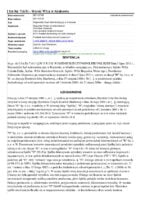
Poland vs “H-S Goods S.A.”, July 2011, Administrative Court, Case No I SA/Kr 716/11
“H-S Goods S.A.” was active in wholesale trade of heating and sanitary goods. The main supplier of the products was a related company from Germany, and the cusomers/recipients of the goods were both unrelated domestic companies and foreign related companies (in Latvia and Ukraine). Approximately 30 % of sales were to related parties. Sales prices for the controlled transactions, were determined based on the purchase prices from the supplier. “H-S Goods S.A.” argued that transactions with the related parties were not sale of goods, but rather provision of warehousing services on behalf of the related German supplier. For these services “H-S Goods S.A.” received a 5% margin. The tax authorities found that the activities and the fact that legal title to the goods was transferred to “H-S Goods S.A.”, meant that the transaction was in fact distribution of goods. Furthermore, the margins obtained by “H-S Goods S.A.” from sale of goods to unrelated customers was considerably higher than the 5% margins obtained from sales to related parties. A complaint was filed by “H-S Goods S.A.” with the Administrative Court. Judgment of the Court The Court dismissed the complaint. According to the court, the tax authorities had proved that the margin on goods sold to unrelated customers was considerably higher than the margin obtained from sales to related parties. The court also agreed that the activities of “H-S Goods S.A.” could not be considered warehousing services. Click here for English translation Click here for other translation
US vs Container Corp., May 2011, U.S. Court of Appeals, No. 10-60515
In this case a US subsidiary, Container Corp, had paid guaranty fees to its foreign parent company Vitro in Mexico. In the US tax return, the fee had been considered analogous to payments for services, and the income was sourced outside the United States and not subject to withholding tax. The IRS held that the guaranty fees were more closely analogized to interest and thus subject to withholding taxes of 30 %. The Tax Court issued an opinion siding with Container Corp. The Commissioner brought the opinion before the US Court of Appeals. The Court of Appeals also found in favor of Container Corp. “To determine what class of income guaranty fees fall within or may be analogized to, the court must look to the “substance of the transaction”. The Commissioner contends the guaranty fees are more closely analogized to interest, while Container Corporation argues that the fees are more closely analogous to payment for services.” “The source of payments for services is where the services are performed, not where the benefit is inured. The Tax Court held that the parent company’s promise to pay in the event of default produced the guaranty fees. The parent company guaranty was the service. Thus, the services were performed in Mexico, and International did not have to withhold thirty percent of the guaranty fees paid.” “Under these factual circumstances, the guaranty fees are more analogous to payments for services, and the income was properly sourced outside the United States. As we find no reversible error of fact or law, the judgment of the Tax Court is AFFIRMED.” The decision from the Court of Appeal The opinion from the Tax Court

Norway vs. Telecomputing, June 2010, Supreme Court case nr. HR-2010-1072-A
This case was about the qualification of capital transfers to a US subsidiary – whether the capital should be qualified as a loan (as done by the company) or as a equity contribution (as agrued by the tax administration). The Supreme Court concluded that the capital transfers to the subsidiary as a whole should be classified as loans. The form chosen by the company (loan) had an independent commercial rationale and Section 13-1 of the Tax Code did not allow for reclassification of the capital transfer The Supreme Court ruled in favor of Telecomputing AS. Click here for translation
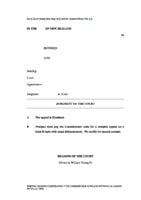
New Zealand vs Westpac Banking Corporation, February 2009, High Court, Case no CA624/07
Westpac Banking Corporation has challenged amended assessments issued by the Commissioner of Inland Revenue to its taxation liability for the years 1999 to 2005. The assessments impugn the bank’s taxation treatment of nine structured finance transactions entered into with overseas counterparties in that period. The funds invested in each transaction ranged between NZD390m and NZD1.5b. By August 2002 Westpac’s total investment in the transactions was NZD4.36b, representing 18% of its assets. The Commissioner says that the purpose or effect of the transactions or parts of them was tax avoidance. He has reassessed Westpac to liability of $586m. With the addition of use of money interest of $375m, the total amount of tax at issue is $961m (including voluntary payments of $443m made by the bank under protest). In brief summary, the transactions were structured in this way: Westpac, acting through subsidiaries, purchased preference shares issued by specially formed subsidiaries (in one case a partnership was used) within a counterparty group of companies in the United States and the United Kingdom. Another subsidiary within the group assumed an obligation to repurchase the shares in five years or less. Westpac paid that subsidiary a fee, known as the guarantee procurement fee or GPF, to procure the parent company’s guarantee of the subsidiary’s obligations. The counterparty jurisdictions treated the transactions for taxation purposes according to their economic substance as loans. Dividends payable on the shares were thus deductible interest for the issuer. By contrast, New Zealand revenue law treated the dividends according to their legal form as income returned to Westpac on equity investments which was exempt from taxation liability. This cross-border differential created the first element of taxation asymmetry inherent in the transactions. The Commissioner makes these allegations: The GPF was an artifice, designed to create a taxation benefit for the parties to share. The mechanism was the dividend rate which was fixed to incorporate both asymmetries and to provide the counterparty with the funds to pay that dividend. By this means the bank was able to offset substantial expenditure against its New Zealand sourced income. And the counterparty received or borrowed large sums at significantly less than market rates. Without this artificial benefit, the financing would never have taken place. The commercial viability of these transactions, the Commissioner says, depended wholly on the achievability of the deductions which were their goal, and on the existence of certain interdependent prerequisites that drove the structure and detail of the arrangements. In particular, he identifies a New Zealand financial institution with a significant tax capacity; a suitable overseas counterparty with a tolerance for tax driven deals; statutory mechanisms within the New Zealand system which Westpac could use to ensure that the income stream was exempt or relieved from tax and to obtain deductions for tax purposes for the costs; and a statutory mechanism within an overseas tax jurisdiction allowing the counterparty to obtain deductions for the distribution stream. Westpac carries the statutory burden of proving what is effectively a negative. It contests the Commissioner’s assessments. The bank says that it advanced real money to real parties and assumed a real and substantial credit risk; that the business purpose of each transaction was to provide funding to the counterparty group; that the transactions, if viewed with commercial and economic realism, made use of specific taxation provisions in a manner consistent with Parliament’s purpose; and that, contrary to the Commissioner’s contention, the transactions were pre-tax positive. The bank denies any element of artificiality, contrivance or lack of business purpose in its use of the specific deduction provisions. It denies also that it shared the benefit of its deductibility entitlement with the counterparty through the dividend rate calculation. And it says that it acted entirely within its legal rights in choosing a structure that used permissible tax advantages. The Judgment In the result, Westpac’s challenge to the Commissioner’s reassessments must fail. The bank has failed to discharge its onus of proving that the Commissioner erred, either in law or in fact. It may count itself fortunate that he did not, on his hypothetical reconstruction, disallow the bank’s claim for its exempt income. Summary In summary, I have found as follows: (1) Westpac’s claim for deductions for the GPF were unlawful, and the Commissioner is entitled to disallow them in entirety; (2) In any event, Koch and the other three transactions were tax avoidance arrangements entered into for a purpose of avoiding tax; (3) The Commissioner has correctly adjusted the deductions claimed by Westpac in order to counteract its tax advantage gained under an avoided arrangement. It follows that I dismiss Westpac’s applications on Koch, CSFB, Rabo 1 and Rabo 2 for an order cancelling or varying the Commissioner’s amended assessment. The case was later settled out of court

Brazil vs Marcopolo SA, June 2008, Administrative Court of Appeal (CARF), Case No. 11020.004103/2006-21, 105-17.083
The Brazilian group Marcopolo assembles bus bodies in Brazil for export. It used two related offshore companies, Marcopolo International Corporation, domiciled in the British Virgin Islands, and Ilmot International Corporation, domiciled in Uruguay, in a re-invoicing arrangement whereby the product was shipped from Marcopolo to the final customers but the final invoice to the customers was issued by the offshore companies. The tax authorities found that the arrangement lacked business purpose and economic substance and, on this basis, disregarded the transactions. Decision of the Administrative Court of Appeal The Court ruled in favour of Marcopolo. According to the Court, the transactions with the offshore companies had a business purpose and were therefore legitimate tax planning. Excerpts “6. The absence of an operational structure of the companies controlled by the Appellant, capable of supporting the transactions performed, even if, in isolation, it could be admitted within the scope of a “rational organization of the economic activity”, in the case at hand, gains greater significance because a) it constituted only one of the elements within a broad set of evidence presented by the tax authority; b) considering the size of the business undertaken (voluminous export), such absence cannot be such that one can even speculate on the very factual existence of such companies; and c) there is no effective evidence in the case records of the performance of the transactions of purchase and resale of products by such companies; 7. even if it can be admitted that the results earned abroad by the companies MIC and ILMOT were, by equity equivalence, reflected in its accounting, the Appellant does not prove having paid Income Tax and Social Contribution on Net Profits on those same results, thus not contradicting the arguments presented by the tax authority authorizing such conclusion; 8. There is no dispute in this case that a Brazilian transnational company cannot see, in addition to tax benefits, other reasons for conducting its operations through offshore financial centres. What is actually at issue is that, when asked to prove (with proper and suitable documentation) that its controlled companies effectively acquired and resold its products, the Appellant does not submit even a single document capable of effectively revealing a commercial relation between its controlled companies and the end recipients of said products; 9. it is also not disputed that the Brazilian economic environment, especially in the year submitted to the tax audit, is likely to lead to higher costs for national companies operating abroad, both in relation to competitors from developed countries, and in relation to competitors from other emerging countries. What is being questioned is that, specifically in the situation being examined herein, at no time did the Appellant at all materialize such costs, demonstrating on documents, by way of example, that in a given export transaction, if the transaction were effected directly, the cost would be X, the profit would be Y, and the tax paid would be Z, whereas, due to the form adopted, the cost would be X – n, the profit would be Y + m, and the tax paid represented Z + p. No, what the Appellant sought to demonstrate is that, considering a historical series of its exports, there was a significant increase in its revenues and, consequently, in the taxes paid. As already stated, if a significant capitalization of funds through evasive methods is admitted, no other result could be expected. (…) Thus, considering everything in the case records, I cast my vote in the sense of: a) dismissing the ex-officio appeal; b) partially granting the voluntary appeal in order to fully exempt the tax credit related to the withholding income tax, fully upholding the other assessments.” “I verify that, when doing business with companies or individuals located in Countries with Favorable Tax Treatment, the legislation adopted minimum parameters of values to be considered in exports; and maximum parameters in values to be considered in payments made abroad, under the same criteria adopted for transfer pricing. Here, it is important to highlight that the legislation did not equalize the concepts of business carried out with people located in Countries with Favorable Tax Regime and transfer pricing. What the law did was to equalize the criteria to control both, but for conceptually distinct operations. Thus, based on the assumption that Brazilian law specifically deals in its legislation, by means of a specific anti-avoidance rule, with transactions carried out with companies in countries with a favored tax regime, I cannot see how one can intend to disregard the transactions carried out by a Brazilian company with its foreign subsidiaries, since these are deemed to be offshore companies in the respective countries where they are incorporated. In fact, every country with a Favorable Tax Regime has, as a presupposition, the existence of offshore companies, in which the activities are limited to foreign business. In the case at hand, there are two wholly-owned subsidiaries of the Appellant, namely, MIC – Marcopolo International Corporation, located in the British Virgin Islands, and ILMOT International Corporation S.A., incorporated as an investment finance corporation – SAFI, in Uruguay. From what can be extracted from the case records, the deals carried out by the Appellant with the final purchasers of the products were intermediated by both companies, and the tax assessment charged, as income of the Appellant, the final values of the deals carried out by those intermediary companies with the purchasers abroad. However, this was not the legal treatment given by Brazilian law to business deals made with offshore companies established in Countries with a Favorable Tax Regime. Law 9430/96 is limited to checking whether the price charged is supported by the criteria set out in articles 18 to 22 thereof; once such minimum parameters are met, the business plan made by the taxpayer must be respected. Therefore, in this case, I believe that the Tax Authorities could not disregard the business carried out by the Appellant with its wholly-owned subsidiaries beyond what Law 9430/96 provides for the hypothesis of companies located in Countries
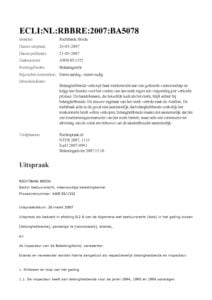
Netherlands vs Shoe Corp, June 2007, District Court, Case nr. 05/1352, (ECLI:NL:RBBRE:2007:BA5078)
This case is about a IP sale-and-license-back arrangement. The taxpayer acquired the shares in BV Z (holding). BV Z owns the shares in BV A and BV B (the three BVs form a fiscal unity under the CITA). BV A produces and sells shoes. In 1993, under a self-proclaimed protection clause, BV A sells the trademark of the shoes to BV C, which is also part of the fiscal unity. The protection clause was supposedly intended to protect the trademark in case of default of BV A. Taxpayer had created BV C prior to the sale of the trademark. In 1994, the taxpayer entered into a licensing agreement with BV C: the taxpayer pays NLG 2 to BV C per pair of shoes sold. Next, BV C is then moved to the Netherlands Antilles, which results in the end of the fiscal unity as of January 1, 1994. The roundtrip arrangement, the sale of an intangible and the subsequent payment of licensing fees, is now complete. In 1999 the royalty for use of the trademark was increased from fl. 2 per pair of shoes to fl. 2.50 per pair, resulting in annual royalty payments of fl. 300.000 from A BV to B BV. The Court disallowed tax deductions for the royalty payments. The payments were not proven to be at arm’s length. B BV had no employees to manage the trademarks. There were no business reasons for the transactions, only a tax motive. Hence the sale-and-license back arrangement was disregarded for tax purposes. Also, the licensing agreement were not found to produce effective protection of the brand and was therefore also considered part of a tax planning plan. Taxpayers often seek to maximise differences in tax rates through selling intangibles to a low- tax country and subsequently paying royalties to this country for the use of these intangibles, thereby decreasing the tax-base in the high-tax country. The arm’s length principle requires taxpayers to have valid business purposes for such transactions and requires them to make sure that the royalties are justified – why would an independent company pay royalties to a foreign company for an intangible it previously owned?’ To adress such situations a decree was issued in the Netherlands on August 11, 2004. The decree provided additional rules for transfers of intangibles when the value is uncertain at the time of the transaction (HTVI). It refers to situations in which an intangible is being transferred to a foreign group company and where this company furthermore licenses the intangible back to the transferor and/or related Dutch companies of this company. In these situations a price adjustment clause is deemed to have been entered. The deemed price adjustment clause prevents a sale at a very low price with a consequent high royalty fee to drain the Dutch tax base. Through the price adjustment clause the Dutch tax authorities are guaranteed a fair price for the sale of the intangible. Click here for translation
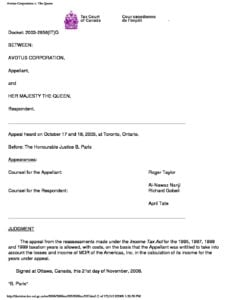
Canada vs. Avotus Corporation. November 2006, Tax Court of Canada, 2006TCC505
The Tax Court of Canada upheld the right of Avotus Corporation to deduct from its Canadian income losses incurred by its subsidiary in Puerto Rico. The Tax Court found that the Puerto Rican subsidiary was Avotus’s agent under a validly executed agency agreement, rejecting the CRA’s claim that the written agreement was unacceptable because the subsidiary’s conduct was inconsistent with that of an agent.
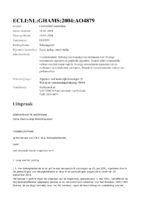
The Netherlands vs X BV, February 2004, Appellate Court of Amsterdam V-N 2004/39.9.
X BV, is member of the English XX-group. One of X’s parents is XX Ltd., based in the United Kingdom. In 1992, X BV acquired licensing rights relating to the trade name J from J Ltd. Their value was determined to be GBP 19.2 million. According to the agreement, X BV paid GBP 19 million for the ten-year economic ownership of the licensing rights. J Ltd. sold the legal ownership to W BV for GBP 200,000 in which X BV owned all shares. In 1996, X BV sells the ten-year economic ownership to W BV for GBP 2 million. To support the GBP 19 million price for the economic ownership, a valuation report is drawn up in 1992. The valuation is based on “projected royalty streams” which showed increasing royalty streams over the ten-year period 1992-2002. The tax authorities disagrees with the price of GBP 19 mio. and argue that the total value of the brand was GBP 43 mio. bases on a continued royalty stream. According to the authorities, GBP 19 million was attributable to the economic ownership and GBP 24 million should be attributed to the legal ownership. In court X BV provided an opinion on the value of the legal and economic ownership of the brand in 1992. In the report it is concluded that the projected income streams did not take into account the Product Life Cycle of the brand. The report states, that to support the brand and to keep the income streams at a high level, investments in the brand will have to be made. No such expenses had been planned and it was very unlikely that there would have been significant income streams after the ten-year period. The Court find there was no evidence that X BV had planned to invest in further support the brand. Hence, at the time of the purchase – the parties did not expect the brand to produce royalty streams after the ten year period. The Court also emphasises that as the royalty stream was in fact in decline in 1994. Click here for translation
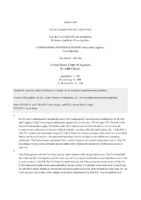
US vs Eli Lilly & Co, October 1998, United States Court of Appeals
In this case a pharmaceutical company in the US, Eli Lilly & Co, transferred valuable pharmaceutical patents and manufacturing know-how to its subsidiary in Puerto Rico. The IRS argued that the transaction should be disregarded (substance over form) and claimed that all of the income from the transferred intangibles should be allocated to the U.S. parent. The Judgment from the Tax Court: “Respondent’s argument, that petitioner, having originally developed the patents and know-how, is forever required to report the income from those intangibles, is without merit. Respondent ignores the fact that petitioner, as developer and owner of the intangible property, was free to and did transfer the property to the Puerto Ricanaffiliate in 1966.” The Court of Appeals altered the judgment from the Tax Court. According to the Court of Appeals, the parent company had received an arm’s length consideration for the transfer of intangibles in the form of stock in the subsidiary. Hence, the Court disallowed the allocation of the intangibles’ income to the U.S. parent.
US vs Laidlaw Transportation, Inc., June 1998, US Tax Court, Case No 75 T.C.M. 2598 (1998)
Conclusion of the Tax Court: “The substance of the transactions is revealed in the lack of arm’s-length dealing between LIIBV and petitioners, the circular flow of funds, and the conduct of the parties by changing the terms of the agreements when needed to avoid deadlines. The Laidlaw entities’ core management group designed and implemented this elaborate system to create the appearance that petitioners were paying interest, while in substance they were not. We conclude that, for Federal income tax purposes, the advances from LIIBV to petitioners for which petitioners claim to have paid the interest at issue are equity and not debt. Thus, petitioners may not deduct the interest at issue for 1986, 1987, and 1988.” NOTE: 13 October 2016 section 385 of the Internal Revenue Code was issued containing regulations for re-characterisation of Debt/Equity for US Inbound Multinationals. Further, US documentation rules in Treasury Regulation § 1.385-2 facilitate analysis of related-party debt instruments by establishing documentation and maintenance requirements, operating rules, presumptions, and factors that impact treatment of a debt instrument as debt or equity.
UK vs. W. T. Ramsay Limited, March 1981, HOUSE OF LORDS, Case No. HL/PO/JU/18/241
In the case of Ramsay a substance over form-doctrine was endorsed by the House of Lords (predecessor of the “UK Supreme Court” established in 2009). The “Ramsay principle” has since been applied in other cases involving tax avoidance schemes in the UK, where transactions have been constructed purely for tax purposes. Statutes referring to “commercial” concepts have also been applied in tax cases where transactions have lacked economic substance.
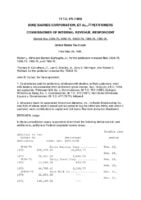
US vs Dixie Dairies Corp., May 1980, U.S. Tax Court, 74 T.C. 476 (1980)
The Internal Revenue Service determined that advances made by Associated Grocers to Radio Broadcasting Co. were not loans but rather contributions of equity, and on this basis a bad debt deduction was disallowed for tax purposes. Opinion of the US Tax Court The Tax Court ruled in favour of the IRS and upheld the assessment where the bad debt deduction was disallowed. In making this decision, the court considered 13 factors: • Names given to the certificates evidencing the indebtedness • Presence or absence of a fixed maturity date • Source of payments • Right to enforce payments • Participation in management as a result of the advances • Status of the advances in relation to regular corporate creditors • Intent of the parties • Identity of interest between creditor and stockholder • “Thinness” of capital structure in relation to debt • Ability of corporation to obtain credit from outside sources • Use to which advances were put • Failure of debtor to repay, and • Risk involved in making advances Click here for other translation
US vs Estate of Mixon, July 1972, United States Court of Appeals, Fifth Circuit, 464 F.2d 394
In this case the court had to decide whether advances made by a shareholder to a corporation constituted loans or capital contributions. For that purpose a list of 13 factors was established by the court. (1) the names given to the certificates evidencing the indebtedness; (2) The presence or absence of a fixed maturity date; (3) The source of payments; (4) The right to enforce payment of principal and interest; (5) participation in management flowing as a result; (6) the status of the contribution in relation to regular corporate creditors; (7) the intent of the parties; (8) “thin” or adequate capitalization; (9) identity of interest between creditor and stockholder; (10) source of interest payments; (11) the ability of the corporation to obtain loans from outside lending institutions; (12) the extent to which the advance was used to acquire capital assets; and (13) the failure of the debtor to repay on the due date or to seek a postponement. NOTE: 13 October 2016 section 385 of the Internal Revenue Code was issued containing regulations for re-characterisation of Debt/Equity for US Inbound Multinationals. Further, US documentation rules in Treasury Regulation § 1.385-2 facilitate analysis of related-party debt instruments by establishing documentation and maintenance requirements, operating rules, presumptions, and factors that impact treatment of a debt instrument as debt or equity.
Berkowitz v. United States, May 1969, U.S. 5. Circuit, Case No. 411 F.2d 818, 820
In July, 1956, the appellants (Berkowitz and Kolbert) formed the taxpayer (K B Trail Properties, Inc.). Each of the appellants paid $2500 cash for one-half of the taxpayer’s authorized stock. They advanced the taxpayer $83,000 to begin business because the taxpayer was unable to borrow funds elsewhere. The taxpayer purchased a 99-year lease on business property utilizing these funds and assumed a mortgage of $57,829.20 as part of the purchase price of the lease. Each appellant took notes from the taxpayer totalling $41,500, payable in four installments of $2,500 commencing July 10, 1957, with the unpaid balance due July 10, 1961, with interest at the rate of 6 percent. In October, 1956, to finance the construction of an additional building on a property, the taxpayer borrowed $40,000 at 6 percent interest from a Savings and Loan Association, secured by a mortgage. In December, 1958, the taxpayer purchased the ground under the leasehold for $50,000. This transaction was partially financed by advances from the appellants in the amount of $5,000 each, evidenced by 15 percent notes due in December, 1959. The taxpayer borrowed $30,000 from a New York mortgage company, evidenced by an 8 percent note secured by a second mortgage on the premises. In 1960 the appellants each advanced the taxpayer $4,000. In 1963 they each advanced the taxpayer $3,600. There were no maturity dates for, or written evidence of these advances. Thus through 1963 the appellants had made unsecured advances to the taxpayer of $108,200, and two lending institutions had loaned the taxpayer $70,000 secured by mortgages. Obviously, the taxpayer was thin to the point of being transparent. Although the taxpayer was timely in its payments to the banking institutions, from 1956 through 1963 the taxpayer had paid only $1,980 toward the principal of the advances made by the appellants. There was no plan to reduce the principal further. In 1963 the taxpayer realized $60,000 from the sale of property, but instead of paying off the long overdue “loans” to the appellants, the taxpayer placed the money in a bank account where it drew a maximum of four and one-half percent, while, at the same time, the taxpayer was paying ten to fifteen percent on the principal of the advances made by the appellants. While the appellants, as directors of the taxpayer, made no effort to reduce the principal amount of their “loans” to the taxpayer, they did meet at the end of each year and decide what interest rate to pay. The taxpayer paid interest to the appellant as follows: 1957 — 4%, 1958 — 8%, 1959 — 15%, 1960 — 14%, 1961 — 10%, 1962 — 10%, and 1963 — 13%. On its income tax returns for the years in issue the taxpayer deducted the “interest” it had paid to the appellants during each fiscal year pursuant to section 163(a) of the Code. The Commissioner disallowed these deductions. Section 163(a) of the Internal Revenue Code of 1954 provides that there shall be allowed as a deduction all interest paid or accrued within the taxable year on indebtedness. The tax authorities disallowed these deductions and increased the taxpayer’s income taxes. An appeal was filed by the taxpayer. Judgment of the Court The US Court of Appeal upheld the assessment of the tax authorities. The Court rejected the appellants’ argument that intent was the controlling factor. Instead, the court noted that the parties had objectively manifested their intent, so subjective intent was not determinative. Excerpts “The appellants had the burden to prove that the advances represented indebtedness rather than equity, and the fact that they intended to make loans and not capital contributions to the taxpayer is not determinative of the equity-capital tax issue. Nor is it decisive that the notes were executed in accordance with state law and described by the appellants and the taxpayer as “loans”. Fin Hay Realty Co. v. United States, 3 Cir. 1968, 398 F.2d 694; Tomlinson v. 1661 Corporation, supra. These are just several of the numerous factors to be considered in determining whether the funds advanced to the taxpayer represented capital contributions rather than loans. We have expatiated on the criteria with some specificity as follows: There are at least eleven separate determining factors generally used by the courts in determining whether amounts advanced to a corporation constitute equity capital or indebtedness. They are (1) the names given to the certificates evidencing the indebtedness; (2) the presence or absence of a maturity date; (3) the source of the payments; (4) the right to enforce the payment of principal and interest; (5) participation in management; (6) a status equal to or inferior to that of regular corporate creditors; (7) the intent of the parties; (8) `thin’ or adequate capitalization; (9) identity of interest between creditor and stockholder; (10) payment of interest only out of `dividend’ money; (11) the ability of the corporation to obtain loans from outside lending institutions. … Applying these criteria to the case sub judice, there can be no doubt that the advances were nothing more than capital transfers as opposed to bona fide indebtedness. Obviously the taxpayer was inadequately capitalized. Considering only the advances made by the appellants, which the taxpayer designated as indebtedness, the ratio of debt to equity would have been about 21 to 1. Adding the institutional indebtedness to the advances made by the appellants would have made the ratio more lopsided.” “The problem is not one of ascertaining “intent” since the parties have objectively manifested their intent. It is a problem of whether the intent and acts of these parties should be disregarded in characterizing the transaction for federal tax purposes. It is not the jury’s function to determine whether the undisputed operative facts add up to debt or equity. This is a question of law. It was correctly decided by the District Court in favor of the government.” Click here for other translation
![UK vs. Duke of Westminster, May 1935, HOUSE OF LORDS, Case No. 19 TC 490, [1935] UKHL TC_19_490](https://tpguidelines.com/wp-content/uploads/TC_19_490-pdf-image-120x200.jpg)
UK vs. Duke of Westminster, May 1935, HOUSE OF LORDS, Case No. 19 TC 490, [1935] UKHL TC_19_490
The Duke of Westminster’s gardener was paid weekly, but to reduce tax, his solicitors drew up a deed in which it was said that the earnings were not really wages, but were an annual payment payable by weekly instalments. The tax authorities held that for tax purposes the true relationship and the true nature of these payments were decisive – substance over form. Judgment of the House of Lords The House of Lords decided in favor of the Duke of Westminster and set aside the assessment. LORD TOMLIN. “… Apart, however, from the question of contract with which I have dealt, it is said that in revenue cases there is a doctrine that the Court may ignore the legal position and regard what is called “the substance of the matter,” and that here the substance of the matter is that the annuitant was serving the Duke for something equal to his former salary or wages, and that therefore, while he is so serving, the annuity must be treated as salary or wages. This supposed doctrine (upon which the Commissioners apparently acted) seems to rest for its support upon a misunderstanding of language used in some earlier cases. The sooner this misunderstanding is dispelled, and the supposed doctrine given its quietus, the better it will be for all concerned, for the doctrine seems to involve substituting “the incertain and crooked cord of discretion” for “the golden and streight metwand of the law.” 4 Inst 41 Every man is entitled if he can to order his affairs so as that the tax attaching under the appropriate Acts is less than it otherwise would be. If he succeeds in ordering them so as to secure this result, then, however unappreciative the Commissioners of Inland Revenue or his fellow taxpayers may be of his ingenuity, he cannot be compelled to pay an increased tax. This so-called doctrine of “the substance” seems to me to be nothing more than an attempt to make a man pay notwithstanding that he has so ordered his affairs that the amount of tax sought from him is not legally claimable. The principal passages relied upon are from opinions of Lord Herschell and Lord Halsbury in your Lordships’ House. Lord Herschell L.C. in Helby v. Matthews [1895] AC 471, 475 observed: “It is said that the substance of the transaction evidenced by the agreement must be looked at, and not its mere words. I quite agree;” but he went on to explain that the substance must be ascertained by a consideration of the rights and obligations of the parties to be derived from a consideration of the whole of the agreement. In short Lord Herschell was saying that the substance of a transaction embodied in a written instrument is to be found by construing the document as a whole. Support has also been sought by the appellants from the language of Lord Halsbury L.C. in Secretary of State in Council of India v. Scoble. [1903] AC 299, 302 There Lord Halsbury said: “Still, looking at the whole nature and substance of the transaction (and it is agreed on all sides that we must look at the nature of the transaction and not be bound by the mere use of the words), this is not the case of a purchase of an annuity.” Here again Lord Halsbury is only giving utterance to the indisputable rule that the surrounding circumstances must be regarded in construing a document. Neither of these passages in my opinion affords the appellants any support or has any application to the present case. The matter was put accurately by my noble and learned friend Lord Warrington of Clyffe when as Warrington L.J. in In re Hinckes, Dashwood v. Hinckes [1921] 1 Ch 475, 489 he used these words: “It is said we must go behind the form and look at the substance …. but, in order to ascertain the substance, I must look at the legal effect of the bargain which the parties have entered into.” So here the substance is that which results from the legal rights and obligations of the parties ascertained upon ordinary legal principles, and, having regard to what I have already said, the conclusion must be that each annuitant is entitled to an annuity which as between himself and the payer is liable to deduction of income tax by the payer and which the payer is entitled to treat as a deduction from his total income for surtax purposes. There may, of course, be cases where documents are not bona fide nor intended to be acted upon, but are only used as a cloak to conceal a different transaction. No such case is made or even suggested here. The deeds of covenant are admittedly bona fide and have been given their proper legal operation. They cannot be ignored or treated as operating in some different way because as a result less duty is payable than would have been the case if some other arrangement (called for the purpose of the appellants’ argument “the substance”) had been made. I find myself, therefore, in regard to the annuities other than that of Blow, unable to take the same view as the noble and learned Lord upon the Woolsack. In my opinion in regard to all the annuities the appeal fails and ought to be dismissed with costs.” This “Duke of Westminster-doctrine” was later set aside in the Ramsay case where a substance over form-doctrine was endorsed by the House of Lords. The “Ramsay principle” has since been applied in other cases involving tax avoidance schemes in the UK, where transactions have been constructed purely for tax purposes. UK vs DUKE OF WESTMINSTER 1935
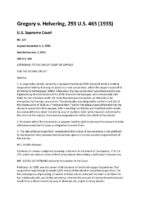
Gregory v. Helvering, January 1935, U.S. Supreme Court, Case No. 293 U.S. 465 (1935)
The first rulings where the IRS proposed recharacterizing transactions that could be considered abusive through use of transfer pricing provisions. Judgment of the Supreme Court The court instead applied the general anti-abuse doctrine. “It is earnestly contended on behalf of the taxpayer that, since every element required by the foregoing subdivision (B) is to be found in what was done, a statutory reorganization was effected, and that the motive of the taxpayer thereby to escape payment of a tax will not alter the result or make unlawful what the statute allows. It is quite true that, if a reorganization in reality was effected within the meaning of subdivision (B), the ulterior purpose mentioned will be disregarded. The legal right of a taxpayer to decrease the amount of what otherwise would be his taxes, or altogether avoid them, by means which the law permits, cannot be doubted. United States v. Isham, 17 Wall. 496, 84 U. S. 506; Superior Oil Co. v. Mississippi, 280 U. S. 390, 280 U. S. 395-396; Jones v. Helvering, 63 App.D.C. 204, 71 F.2d 214, 217. But the question for determination is whether what was done, apart from the tax motive, was the thing which the statute intended. The reasoning of the court below in justification of a negative answer leaves little to be said. When subdivision (B) speaks of a transfer of assets by one corporation to another, it means a transfer made “in pursuance of a plan of reorganization” [§ 112(g)] of corporate business, and not a transfer of assets by one corporation to another in pursuance of a plan having no relation to the business of either, as plainly is the case here. Putting aside, then, the question of motive in respect of taxation altogether, and fixing the character of the proceeding by what actually occurred, what do we find? Simply an operation having no business or corporate purpose — a mere device which put on the form of a corporate reorganization as a disguise for concealing its real character, and the sole object and accomplishment of which was the consummation of a preconceived plan, not to reorganize a business or any part of a business, but to transfer a parcel of corporate shares to the petitioner. No doubt, a new and valid corporation was created. But that corporation was nothing more than a contrivance to the end last described. It was brought into existence for no other purpose; it performed, as it was intended from the beginning it should perform, no other function. When that limited function had been exercised, it immediately was put to death. In these circumstances, the facts speak for themselves, and are susceptible of but one interpretation. The whole undertaking, though conducted according to the terms of subdivision (B), was in fact an elaborate and devious form of conveyance masquerading as a corporate reorganization, and nothing else. The rule which excludes from consideration the motive of tax avoidance is not pertinent to the situation, because the transaction, upon its face, lies outside the plain intent of the statute. To hold otherwise would be to exalt artifice above reality and to deprive the statutory provision in question of all serious purpose.” Click here for translation
